Electric Multiple Unit Stock
NB The sketches used for illustration are NOT scale drawings - Illustrations, where provided, are sketches not scale drawings and were intended to show the various livery changes, so matters below the solebar tend to get rather impressionistic. I have to admit I have little interest in or information on the EMUs, having been put off the modelling by the complexity of adding the associated overhead wiring or third rail. I am deeply indebted to the members of the uk.railway and uk.rec.models.rail newsgroups who have provided a great deal of the information and, sadly, many corrections for the text.
Note There is a fore-shortening effect when a locomotive is viewed from the normal 'three quarter view' angle, making it appear rather shorter than it is. The photo below shows this effect. When preparing sketches I have tried to find photographs to work from taken at as flat an angle as I was able however this has not always been possible.
Model of a driving motor trailer 5-BEL 1932 Brighton Belle set (BR Class 403a)
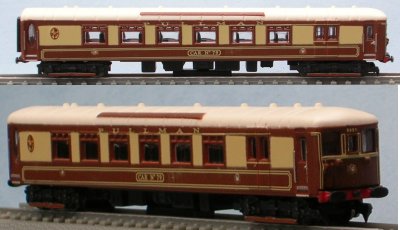
Photo of model courtesy Ian and Sandra Franz
Electric traction has much to commend it for high intensity suburban services, electric units have rapid acceleration, run quietly and unlike steam or diesel engines can operate in tunnels without requiring substantial extractor fans to keep the air breathable. Regenerative braking, in which the traction motors are switched to act as generators, pushing power back into the supply lines, reduces the cost of electricity, on a suburban system with a lot of stops and starts this can reduce the power required by up to 20%. Electric traction is also cheaper to run than either steam or diesel, a BR study in the 1960s found electric traction to be about a pound a ton-mile cheaper to operate, although a substantial initial investment is required in infrastructure. As a result the decision was made to undertake the electrification of long distance routes as well, starting with the West Coast Main Line and then (after many years of delays) the East Coast Main Line as well.
There are three forms of supply used on British lines, third rail, battery power and overhead wire.
Third rail supply offers several advantages, low initial cost being one. Third rail systems use the running rails as the electrical return path with the current supplied via a rail, usually running beside the track and mounted on insulators. Some lines used a four rail system with a separate return rail also mounted on insulators usually running between the running rails. The four rail system is standard on underground lines where the damp conditions cause too much leakage on a three rail system but it has been used on some above ground lines in the North London area as well. Three (or four) rail systems do have some disadvantages however, they do not cope well with snow and ice, they have to use comparatively low voltages (or the insulated rail(s) would need to sit very high on large insulators) and they represent a hazard to anyone, or anything, walking on the line (small mammals are regularly found dead along third rail routes). To get round this final problem it has been common practice to equip some locomotives with overhead pick-ups which are used with light 'tramway' type overhead supplies in yards where people might need access to the tracks.
An alternative way of dealing with yard traffic would be a battery powered loco to deal with shunting duties, these have existed since about the turn of the century but they have always been rather rare. The London Underground lines employ a number of battery powered locomotives, mainly for engineering work but also to haul trains when the normal supply has to be interrupted for maintenance. In the 1950s BR built some Class 419 (MLV) motorised brake vans, based on a standard BR Mk1 brake coach fitted with a battery pack. These were used on electric multiple units heading for the ferry ports, once in the port area the battery power could be used to move the rake about. These are discussed under Class 419 heading below.
Battery power has only been used as the sole power supply on one passenger unit, technically a BEMU or Battery Electric Multiple Unit. This was the Ballater Battery Unit which operated in Scotland from 1958 to 1962. This unit was based on a two-car Derby Lightweight diesel unit fitted with a battery pack in place of the engines (it is discussed in detail at the end of this section).
Overhead supply allows the use of alternating current at higher voltages and offers less of a safety hazard than third rail systems. The power lost by heating the conductor wire is proportional to the square of the current carried, so using higher voltages and hence lower current offers some savings in transmission costs and the supply wire can be much smaller than with low voltage systems. The drawback is the cost of the installation and the difficulties of maintenance. The power pick up has also proved to be a problem, the simple 'pole with a pulley wheel' type pick up used on many tram systems (technically called a trolley pole system) tends to come off the wire at higher speeds or when the wire has a 'frog' for a diverging route. The trolley pole was (and is) used on the Isle of Man Electric Railway, however this is in fact more of a tram system operated at comparatively low speeds. By about 1900 someone had come up with the diamond pantograph (named after a similar looking drawing instrument used to scale drawings). This has a horizontal bar supported by two hinged diamond shaped supports held in the 'up' position by springs or (on more modern systems) compressed air. This allows the wire to wander off the centre line of the track slightly and provides adequate pick up at moderate speeds. This type of pick up was standard on British lines into the 1950s but development work on the Lancaster-Morcombe-Heysham line in the 1950s produced the slightly more elegant 'arm and elbow' or 'singe arm pantograph' type. As speeds increased the aerodynamic qualities of the pantograph became increasingly important and the single arm pantograph evolved into the modern high speed type used on trains such as the Pendolino.
Fig___ Pantograph designs used on British EMUs

'A' is the early double-diamond pantograph used on British stock right up to the 1960s. Usually associated with DC supply it was also used on the pre-BR AC supply systems.
'B' Is the Stone-Faiveley single arm pantograph developed in the 1950s, as fitted in pairs to all the original AL1 to AL5 series engines and widely used on multiple units.
'C' is the Faiveley design dating from the 1960s and used on a number of multiple units and on some early locomotives. This design had a substantial frame of one inch tubular metal and hence is sometimes called the 'bicycle frame type'.
'D' is the BR/Brecknell, Willis Pantograph, developed in the mid 1970s, which is now used on British high speed units and locomotives as well as on systems in many countries world wide.
All pantographs have a drooped part on each end, originally this was to prevent the current wire from getting underneath the pick-up bar. These 'horns' as they are called still serve that purpose but since the 1950s they have incorporated a fragile section which if damaged lowers the pantograph out of harms way.
EMUs by their very nature are suited to electric lighting and this was also used for 'headcode' lighting as well (two white lights for a 'stopping passenger train' at the front and one or two red lights at the rear). Electric lights were however very unreliable and oil lamps, particularly tail lamps, remained in occasional use on electric multiple units well into the 1980s. The front lamps were replaced by the alpha-numeric headcode in 1960 (see Communications, Control and Signalling - Bell Codes &Locomotive Head Codes
for more information on this) but the tail lamp is there so a signalman can see that the train is still complete and nothing has been left behind in the section. The use of automatic continuous brakes should prevent a multiple unit loosing part of its train, however there have been accidents (involving air braked freight stock) where the braking system was either not properly tested on not correctly set up. I have yet to see an oil lamp on a second generation EMU (these all have red electric tail lights built in), and there is as far as I am aware no lamp bracket to mount one, but doubtless someone somewhere will e-mail me an example.
Pre-BR Electric Multiple Units
The first electric trains on the London Underground railway system appeared on the City &South London Railway of 1890, at first locomotives pulling coaches were used but within a few years the electric multiple unit was established as the norm and the inner London underground system was fully electrified using a four-rail system by 1905.
In 1898 Waterloo and City line began operating, the second 'deep tunnel' or tube line, often referred to as 'the drain' this was the first underground line to use EMUs from the start. These were not the more complex type where control signals are passed along the rake but a simple driver control design with full voltage passed along via a roof mounted jumper cable. The line used a three rail system (unusual on underground lines) and the original wooden units remained in operation until 1940 when the line was converted to the SR standard 3rd rail system used on surface lines. This changed again in 1993 when the standard London Underground four-rail system was installed. It has only the two stations of its name (the latter since renamed Bank). It was promoted by the LSWR (providing a link between the City and their Waterloo surface station) and later purchased outright by that company. It passed to the Southern Railway and then to BR, remaining part of the national rail network until 1998 when the line was absorbed into the London Underground administrative system.
Liverpool City Lines
The Liverpool Overhead Railway, a four-rail system running EMUs on an elevated track running along the Mersey above the road outside the Liverpool docks, went into service in 1893. First promoted in 1878 by a ship owner (Alfred Holt) as a way of keeping the roads open for freight, Acts to enable the building of the line were passed but it took several years for the Mersey Docks and Harbour Board (a non-profit organisation) to start construction (meanwhile in America the New York Overhead Railway went into operation in 1881). There was some concern about how the MDHB could operate such a line so it was sold off and became an independent company in 1888. The line ran above the existing freight lines connecting the warehouses on an iron structure roughly sixteen feet above ground level. The original terminus at Seaforth Sands was subsequently equipped with the second escalator in Britain (in about 1901), although this was removed after a series of claims from ladies with long skirts which had become caught and torn in the treads.
This was the first open air electric railway in Britain, the current supply and return rails were mounted outside the running rails, one to either side. The original passenger stock consisted of two-coach wooden bodied, matchboard sided, units and I understand from talking to a lady who used the service in the 1940s the seats were plain slatted wood. Later additional centre cars were produced enabling three coach trains to run, these may have been slightly longer than the original cars but I am not sure on that point. The duckets on the cab sides for the guard (or possibly the driver) had a window on the side and rear but not to the front, these gave the original units a very short and fat look when viewed from the front.
Fig___ Original Liverpool Overhead Railway commuter train
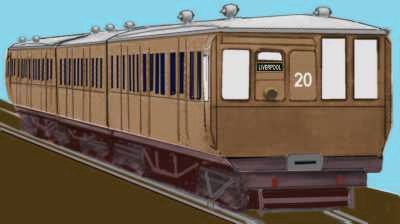
In 1947 the multiple units were rebuilt, retaining their original chassis but fitted with a new aluminium body. The new aluminium bodied vehicles had two pairs of air operated sliding doors fitted in place of what the single hinged doors on the original wooden bodies units. An electric headlamp was mounted low down on the front of the cab and the new cabs had no side 'duckets'. When first converted the third class accommodation was marked by an ornate number three, I think in yellow (or white) shaded red (or black) repeated twice on the side of the car. I would assume the first class section was similarly marked with a number 1.
Fig___ Liverpool Overhead Railway aluminium bodied commuter train
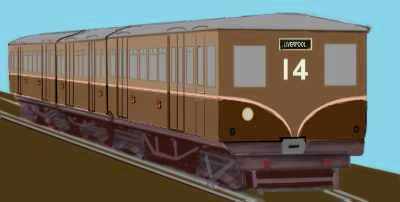
As built the line served only the dock area but within a year it was extended to Seaforth where it connected with the Lancashire and Yorkshire line to Southport (which was electrified a few years later, see below). At the opposite end an additional extension into the suburbs of Dingle ran across a Cheshire Lines Committee goods yard on a large lattice girder bridge thence into a tunnel leading to an underground station (slightly odd for an 'overhead railway' and an interesting basis for a potential exhibition layout). The LOR was a pioneering line in many ways, it was the first line in the world to use automatic train detection to control signalling. The first serious use of colour light signals was on the Liverpool Overhead Railway where over fifty two-aspect (that means two lens) colour light signals were installed in 1921. The LOR also operated an electric tram service connecting Seaforth Sands to nearby residential areas.
The LOR closed in 1956 due to corrosion in the iron structure supporting the line.
The LOR did own a single, very small, 0-4-0 well-tank steam engine (this was Kitson number T261 of 1893) which survived, complete with dumb buffers, right to the end of the line in 1956. When the LOR closed this engine was sold on to REA Ltd at Monks Ferry coaling wharf, Birkenhead, and was finally scrapped in 1961.
Electric trams appeared in the streets in the later nineteenth century and soon began eating into the railways suburban customer base. At the time the Mersey Railway, which operated a steam hauled line between Liverpool and Birkenhead via the famous Mersey Tunnel (opened in 1886), faced competition from trams serving the new faster ferries. The Mersey Tunnel was a pretty grim experience with steam traction, the 'condensing engines' produced too much sulphurous smoke and the extractor fans did not work as well as had been hoped. In 1903 the company adopted electric traction, the first steam railway to switch to all electric operation. It was electrified using a four-rail system but I believe trains from the later 1930s LMS 'Wirral' three rail system were also able to use the tunnel in later years (these 'Wirral' units became Class 503 under BR and are discussed below). I believe the 'return' rail on this line was mounted on the outside of the running rail whereas most four rail systems have the return running between the running rails.
Mersey Railway EMU
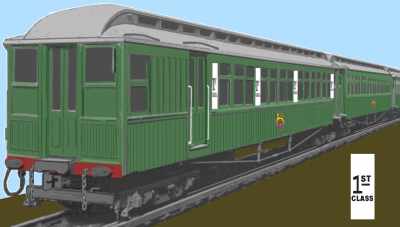
The sketch shows what I think is an original 1903 Mersey Railway unit in the early BR era, closest is the first class coach, indicated by the signage on the white panels as shown inset. The earlier livery was lined with a two digit unit number displayed under the windows to either side of the cab front but I have not so far confirmed the colours used. The unit has a knuckle or 'Buckeye' coupling but also has rudimentary buffing plates and the 'safety chains' required on early passenger stock are still in place. In the 1940s some elderly London Transport four-rail stock was transferred to serve on the Mersey Railway to meet wartime demand. This was (I understand) built to something like the standard loading gauge and hence probably ex LNWR stock or ex LMS stock (built in 1927 and rather similar to the Altrincham and Manchester sets in appearance) which had be due for scrapping. In the 1950s the line was converted from four to three rail and the original trains, and the ex London stock, were retired.
NER-LNER Tyneside third rail electric units
The NER electrified part of their suburban rail network on the Tyne in 1903 in order to compete with the new electric tram systems. This was Britain's first all electric suburban rail network (using outside third rail pick-up) and was soon turning in a healthy profit. As part of this project they also electrified the line down to the docks, which ran through a steeply graded tunnel. For the dock like they built some Bo-Bo locomotives with overhead as well as third rail current collection but for the passenger services they opted for EMUs. I was not able to find out very much about this system, particularly the EMUs, and I am grateful to Tim Illingowrth for supplying much of the detail and Rich Mackin for a pointer on the livery. Tim advises that Volume 10b of the North Eastern Record - 'railcars and electric stock' published by the North Eastern Railway Association covers this stock in some detail (the whole series is very informative and well worth a read).
The NER built a fleet of electric passenger units for the line which were painted crimson lake (a dark red similar to Midland Red) on the lower body with cream upper body and a white roof. These units appear to have been single car units but able to operate in multiple (three or four), some units had luggage compartments whilst others were all-third passenger vehicles. The unit has no buffers but on the photographs I have seen it was not possible to make out the details of the couplers, these must have been a combined buffer-coupler of some description and I believe they may have been of the 'knuckle' or 'buckeye' type. The sketch below is based on a photograph of one of the passenger units introduced on the North Tyne third rail system in 1903, there were several designs in use all broadly similar.
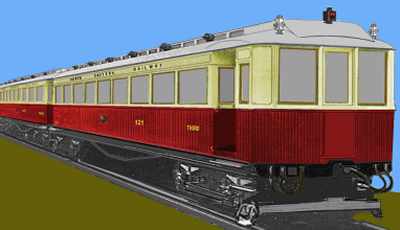
This enterprise was a success and there were plans to extend the electrification but matters came to a halt when the First World War broke out. Following a depot fire just after the First World War the NER built some additional units in 1920 to a rather more modern design. The sketch below is extremely provisional, based on a single low resolution photograph with little detail visible on the coach sides (the front end is about right). They built a number of different vehicles, which presumably were assembled into sets for specific routes, including quite a few double cabbed units (able to operate as single cars, some with luggage space) and enough single cab units and coaches to make up five five-car sets as well as a double ended parcels van. They used the Buckeye type buffer-coupling. The livery was all NER red (similar to Midland red) with dark grey roof and black chassis and the original triple lamp arrangement on the cab roof has been designed in to the destination indicator support as three electric lights (there are also two lamp brackets under the front windows for oil lamps if required).
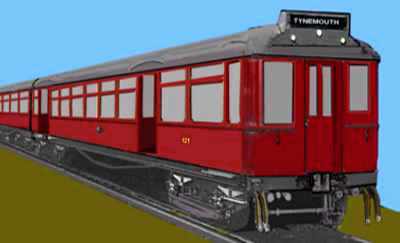
There was no gangway connection visible on the cab front door but it is possible that a simple drop-plate was used to provide access between coaches. The sides of the coach were flat rather than curved as would be normal on passenger stock.
In 1923 the NER became part of the LNER, who favoured building carriages from teak. Teak is unsuitable for painting (having a lot of oil in it) and is normally varnished, on non teak stock such as the Tyneside units the LNER adopted a 'teak brown', which I gather was rather drab. The LNER extended the suburban electrification to areas south of the Tyne in 1937 and built additional articulated two-car stock for the expanded network. These retained the flat sided appearance of the NER design but had a three-arc roof profile. These LNER two car units could and did operate in multiple, typically three pairs forming a train. From 1938 they were repainted in red and cream with a dark grey roof and in 1941 this changed to Marlborough blue and Quaker grey, still with the dark grey roof. On the only photo I have found of the 1941 colour scheme there appears to be a dark stripe, black or possibly dark blue, run along the join between the blue and grey. The LNER did not carry on with the three roof mounted lights but adopted a four electric lamp cluster, mounted below the left hand cab window (viewed from the front) with what may have been a fifth electric lamp above the same window.
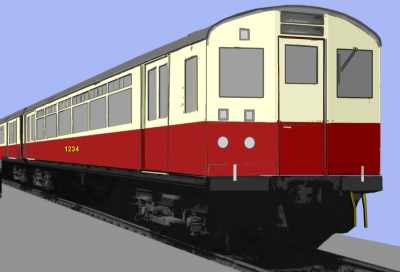
The window in the gangway door was subsequently either painted over or plated over, by the time these units were repainted BR green the window was no longer visible and the unit number had moved from the centre of the coach to under the cab window.
After the Second World War the railways were nationalised and BR repainted the Tyneside stock in multiple unit green from 1949. In the early 1950s BR built some two-car (2-EPB) replacements for the older units. In 1967 BR decided not to refurbish the Tyneside electric rail system and switched to DMUs. The BR built third rail units (2-EPBs) were transferred to Southern Region where they remained in service for many years. The sketch shows the livery during their time on Tyneside, note the five lamp cluster on the front, which was I believe something to do with the Tyneside system.
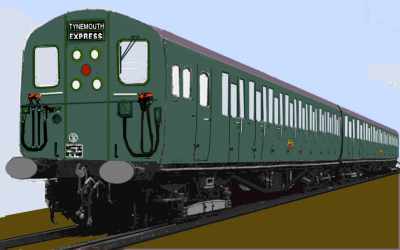
When transferred to Southern region I believe some of these units had the inverted black triangle on the small yellow warning panel indicating the end nearest to the guards compartment.
The replacement DMUs were second hand units transferred from other areas and had to operate a slower timetable, which was found to be much less satisfactory. As a result many of the former NER and LNER electrified lines were then re-electrified with an overhead supply in 1979 as part of the Tyne & Wear Metro light rail system. The Metro (which includes one of the three British underground systems, along with Glasgow and London) then became the model for many other urban light rail systems which were set up across the country.
Lancaster-Morecombe-Heysham Stock
The Lancaster-Morecombe-Heysham line was built by the North Western Railway (Not the London North Western, this was a much smaller company), in the 1870s the line was purchased by the Midland Railway. The Midland then built a new docks complex at Heysham, to avoid using another company line (The Furness Railway) to the small port at Morcombe. In 1908 the line was electrified using a 6.6 kV, 25 Hz a.c. overhead line system. The Midland Railway already operated a generating station, supplying its wholly owned dock complex at Heysham, and that determined the type of power to be used. The overhead line was described in one article as being metal I section bars, supported on timber poles with a cross bar, however the only photographs I have found shows a catenary wire system at Heysham station and on the aproach to Morecombe station. To operate the line three motor coaches were purchased, all 60 feet long, and with a pick-up and driving cab at each end. In use they could operate in multiple but I believe they normally operated with either one or (more usually) two driving trailer coaches. The electrical equipment on two of the cars was supplied by Siemens, the third used Westinghouse (USA) kit. The driving trailer cars were a mix of new-built and converted coaches. The sketches below show a motor coach, equipped with diamond type pantograph pick-up and a three car set on which the centre car has bow collector pickups. The latter was sketched from a photograph from a book published in 1910 which had been scanned and uploaded by Chris Tolley to the alt.binaries.pictures.rail newsgroup. This group is usually supplied by photographs of modern scenes but occasionally people will upload vintage material as well. Well worth keeping an eye on.
Fig___ MR electric motor coach and three car set
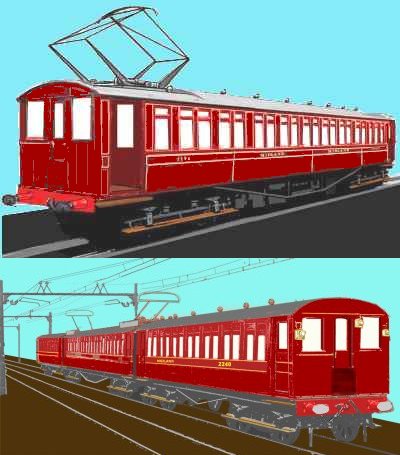
Plans to extend the electrification were developed after the First World War but the hard years of the 1930s prevented the work. The original passenger units proved reliable however and had a long life, being scrapped in 1951. The line was then converted for 50Hz overhead operation for experimental purposes and used in the development of AC systems for the new 25kV systems. During the change over the line was supplied with three coach rakes of push-pull stock and some ex LMS 0-4-4T engines. The first electric units to use the 50Hz system were the BR Class 301, these were rebuilt LNWR fourth-rail units from the Watford line in London that had been in storage since the 1940s.
Lancashire & Yorkshire Railway Electric Services
The Lancashire and Yorkshire Railway had a lot of commuter traffic between the various cotton and wool towns, ports and industrial centres. In 1904 they introduced a third rail electric service for the heavy commuter traffic on the Liverpool to Southport line, the first main line in Britain to be electrified. The L & Y settled on 630 volts DC and used electric multiple units for passenger services on this line.
The sketch below shows the original four-coach type of L&Y Railway electric unit operating between Liverpool and Southport in 1904. The sketch is based on a photograph I found on the Science and Society website, http://www.scienceandsociety.co.uk , which is an invaluable resource and well worth exploring. The livery used appears to be standard L & Y passenger colours, light tan (similar to Humbrol 'light earth') upper panels and dark tan (a dark reddish brown) lower sides.
Fig___ Early L&Y Railway EMU
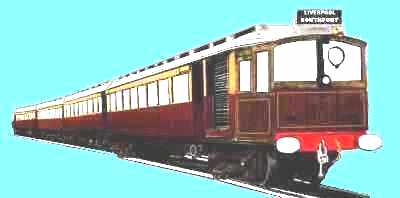
One point to note is the circular fitting on the drivers windscreen, windscreen wipers were only invented in 1906 (by a lady called Mary Anderson of Alabama), some years after this railway service began, and my first thought was that this was a 'clearview screen', a rapidly rotating disc of glass that throws off the rain. Clearviews are popular on ships, simple, effective and a lot quieter than wipers. However the clearview requires a central support, not evident in the photograph, so I suspect it is a hinge-down 'porthole' type opening to allow the driver to get a decent view in the rain.
I have seen a photograph showing two of these L & Y driving trailers with ten (non clerestory) intermediate coaches sandwiched between them, this was operating a special high capacity service for a horse racing meeting at Aintree some time before 1910. The photo was taken from a book published in 1910, it was scanned and posted on the alt.binaries.pictures.rail newsgroup by Chris Tolley in June 2006.
I gather the LMS purchased some additional units for this line in 1927. These new units were based on their standard suburban coach design and would probably have resembled the Altrincham line stock shown below, although without the pantograph. The original L & Y units as shown in the sketch continued in use until replaced by the LMS with completely new stock in 1939 (under BR the LMS 1939 built units became Class 502, described below). The 1939 LMS units featured sliding doors, these were the first sliding doors on non-underground stock and they were not seen again on British coaches until the electrification of the Glasgow Underground in 1960.
In 1913 the Lancashire and Yorkshire electrified the Bury to Holcombe Brook line at 3500 Volts DC using an overhead supply. Two two-car units were built for this line, the design used had lost the clerestory roof (replaced by large shell type ventilators) and gained a flat front with a central gangway and a window to one side, looking much like EMUs ever since.
Fig___ 1913 L&Y Railway Bury to Holcombe Brook EMU
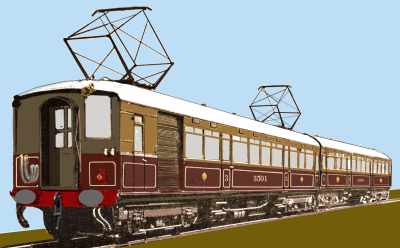
In use a red bodied, red lensed, tail lamp was on the rear below the drivers window as shown in the sketch.
Later, in 1916 the L & Y line from Bury to Manchester was electrified using 1200 volts DC and a third rail system. Unusually the third-rail pick-up ran in a slot on the rail rather than along the top (as in the three rail systems used in London and the North East).The Holcombe branch was then converted to three rail 1200v (in about 1917) and the original two-car units from the Holcombe branch were stored. In 1927 they were converted to form an experimental diesel electric four-car DEMU set for the LMS. A 500hp engine and associated generator was fitted to one of the power cars and the set operated between Blackpool and Lytham for about a year (1928-1929). I understand that this line was re-electrified again using 1500v DC overhead supply but then de-electrified before it closed to passengers in the 1950's.
The 1916 Manchester-Bury sets were built to the same basic body design as the Holcombe branch two-car sets but for this service the ' & Y opted for five coaches and had jumper cables to allow multiple working, hinting at a fair bit of traffic on the line. Again the livery used appears to be standard L & Y passenger colours, light tan upper panels and dark tan lower sides.
Fig___ 1919 L&Y Railway EMU
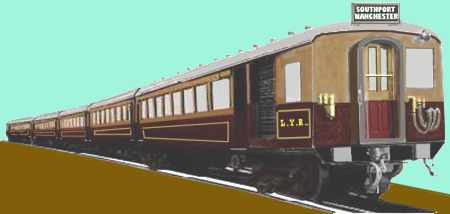
Although there were no buffers there were reinforced sections on the buffer beam, suggesting that these units used a combined buffer coupling of some description.
These units continued in use until replaced by the Class 504 1200V dc 3rd rail units built by BR in 1958. These then continued in use until 1991 when the former L & Y line was absorbed by the expanding Mancheaster Metrolink 750v dc overhead wire light rail network and switched to that systems overhead supply.
Manchester South Junction & Altrincham
Railway 1500v DC overhead supply
The Altrincham-Manchester units were built by the LMS using their standard compartment coach body construction but fitted with 1500v dc traction using overhead wires and equipment provided by Oerlikon. They were very similar to units built for the third rail Liverpool-Southport and Watford-Euston services in 1927, the Altrincham three-car sets entered service in 1931 and lasted until 1971 when the line changed to 25kv operation. The switch gear was sandwiched in between the drivers cab and the guards compartment at one end of the three coach rake, the pantograph (a double-diamond type) being mounted above. The units could operate in multiple, giving a six coach train for busy periods (notably during the cricket matches at Old Trafford ground, served by this line) but only the coach with the pantograph was powered.
Fig___ Altrincham-Manchester unit
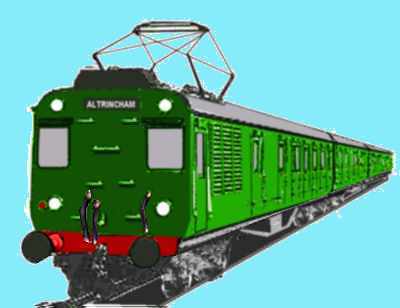
The units were delivered in what is described as 'green and yellow livery', I remember them as being all over green, perhaps with yellow numbers but I do not recall any lining as such.
I used this train during my time at college in the 1960s and found it comfortable and efficient, well up to the standard of the BR MK.1 and the Class 304 and 305 25 kV electric units used on my local (Styal) line. The drop-light door windows, operated by a leather strap with holes that engaged on a brass pin on the inside of the door, did strike me as somewhat antiquated even then. One odd feature was a compartment reserved for women and marked Ladies Only, which if memory serves was immediately behind the guards compartment at the pantograph end of the rake. This was a 'first class' standard compartment with very plush seats and well maintained. I know this as I got into it on my way to college one morning, deep in thought, and as the journey progressed slowly realised I was unusually comfortable but experiencing very chilly glances from my fellow passengers, all of whom were women. It was only when I left the train and closed the door that I saw the sign and realised what I had done to annoy them so much.
London Suburban Services
Meanwhile, in the London area, various companies were establishing electrified surface lines to handle the high density commuter traffic. The electrified lines were of most use in the city itself where the many lines in tunnels benefited greatly from the move away from steam traction. EMUs used in the London suburban area included the LBSC 6.7kV AC overhead supply services introduced in 1909 (these were converted to third rail by the SR in about 1929). These services used EMUs with twin boom 'bow collectors', one fitted above each driving cab, only the 'trailing' collector (the one of the cab in use) would be raised when in use. The original 1909 units were three car sets with driving trailers to either side of a power car, additional units were built over the years, I believe most operated as three car sets although the later batches ran as five car sets. The Burnt Umber and White colour scheme (essentially the same as used on Pullman coaches) was introduced in about 1901, replacing a range of liveries used by this company on passenger stock. Lettering was on the waist panels in yellow shaded blue. This was replaced from about 1911 by umber. The sketch below is based on a photo taken in the SR era (with an all-green livery I believe). NB this sketch is highly provisional, especially regarding the colour and the fittings on the bowed cab front (the white oil lamp shown by the drivers window was taken from a photograph) however 'Steve' on the uk.rec.models.rail newsgroup was able to advise- From 1911 LBSC electric trains were painted in passenger umber. As regards the gubbins on the cab the route indicator was illuminated externally plus there was a destination board. The tail lamp was a spectacle that covered a lamp. The trains were air braked braked.
Fig___ LBSC 6.7kV unit
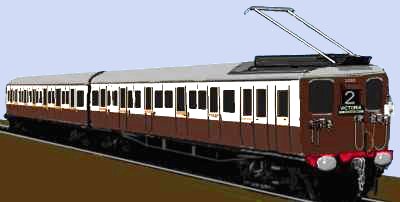
I believe that when new these LBSC units may have had a protective rail, angled outwards and supporting a metal mesh, at the front and sides of the pickup base.
The LSWR introduced a system using 600v DC third rail supply on their Brighton line, starting in about 1913 following the lead set by the 1904 L & Y Southport line. I have seen reference to an LSWR AC powered service but I have no data on that and I suspect the writer was referring to the LBSC lines. The livery shown below is the pre-1915 salmon pink and dark brown, in 1915 this changed to all over green, as adopted by the later Southern Railway for their EMUs. The route indicator on the front, in LSWR days, was a metal stencil as translucent roller blinds were not yet available. The sketch is somewhat provisional in many respects, the only photo I found was taken at a steep angle, revealing little detail of the sides. I believe the units were all compartment stock, based on the standard LSWR bogie coach and having a timber chassis. They were initially produced as three car sets with a driving trailer (equipped with pickups) to either side of a power car, they had jumper cables so they could operate in multiple if required. About eighty of this type were built, in about 1920 I believe some five car units were produced, but I have no details on those.
Fig___ LSWR unit
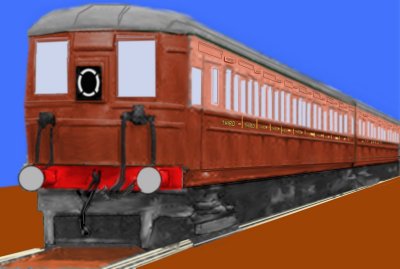
In the North London area the LNWR set up a 630v DC four rail system which began operating about the time of the First World War. The LNWR track had a conductor rail on the outside and a separate insulated negative return rail between the running rails, a similar system to that used on most (from about 1940 all) of the London Underground (where earth leakage in the damp tunnels made a three rail system impractical). This allowed underground trains to use LNWR lines to reach out into the suburbs. The sketch below shows an LNWR unit equipped with electrical gear by Oerlikon, there were also similar units but with lots of doors (possibly compartment stock) built using GEC electrical equipment.
Fig___ LNWR four rail stock
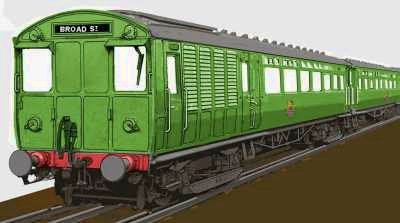
The four circular fittings on the cab front are covers for electric lights, the two at the top (either side of the destination indicator) show white (the headcode for a stopping passenger train), the two lower lights show red (used when the cab in question is at the rear). The covers slide to the side to reveal the light, they appear to have been operated from inside the cab. It was standard practice to add a red lensed white bodied oil lamp on one of the lamp brackets at the rear of the train (electric lights were considered too unreliable to be trusted as the regulation red light at the rear of a train). There is a photo on John Turners photo website (see App 6 Contributors and Bibliography, the photo is in the 1950s section) showing the rear of one of these units with the red electric light showing and an oil lamp on one of the brackets.
I believe the LMS purchased additional units in 1927 for the former LNWR lines, based on their standard steam hauled suburban coach design. These looked very like the Altrincham and Manchester line units and were used on a Watford to Euston service. In the 1940s I understand some four-rail stock (either LNWR or the 1927 LMS type) was transferred to the Mersey Railway to meet wartime demand. This would have been scrapped when that line changed from four to three rail in the mid 1950s.
The SECR had a plan (established in 1903 and based on 1500v DC overhead supply) but this was not implemented until the SR era, by which time the third rail system was standardised.
I understand that the LNER electrified various former GER and GNR lines in the London suburbs using 1500v DC overhead supplies (with which they were familiar from the lines in the North East). I am not sure when this work was done exactly but these lines were subsequently changed to the BR 25kV standard supply (discussed below).
The GWR had no electrified lines in the London area (or anywhere else that I am aware of) but they did have some involvement with the underground. There was a link to and working arrangement with the Central London line underground service based on the Ealing and Shepherds Bush Railway scheme which allowed GWR freight to access inner London and Central London line underground trains to access suburbs (power was supplied by the GWR power station at Park Royal). The GWR also enjoyed joint ownership of the Hammersmith and City line with the Met. The GWR, with its broad gauge, did not feature greatly in the early London suburban services, later with the adoption of standard gauge they built narrow-bodied four wheeler 'London suburban' coaches suitable for use on the underground sections of lines they had interests in (mainly I believe the joint lines with the Met) but I believe these were all steam hauled. These coaches had curved tops to the doors so they would not catch on the tunnel walls if opened when the train was in motion. I understand that the jointly operated coaches had GWR and Metropolitan Joint Line or Metropolitan and GWR Joint Line on their sides, depending on the owning company. The GWR four wheelers were subsequently dispersed throughout the GWR system and intermingled with other four wheeled stock (mainly used on 'workmens trains'). I have not found any references to GWR owned electrically powered rolling stock however the Central Line trains gained running powers over part of the GWR system so the electrification must have extended some distance.
Over time the London suburban network settled down and the post-grouping SR settled on a 660v dc third rail supplies but under the LMS the four-rail LNWR system remained, it was finally changed to three rail in the 1970s. Even then the fourth rail was retained as it formed part of the electrical return path, this also allows underground units to access the lines (on lines where these did not wander the rail remains in place but is not maintained). (I am grateful to Mr G. Harman, a regular on the uk.rec.models.rail newsgroup for clarification of the four rail system). By the 1920s and certainly into the 1950s the three-rail Southern Electric system was the largest electrified suburban service in the world, a study in the 1950s suggested it was also the most efficient people-moving thing on earth.
The three and four rail systems presented problems in yards where men had to work so it was not uncommon to fit some locomotives with overhead pick up apparatus for use in the yards, switching to third rail when working on the main lines. As the 25kV system was implemented after the Second World War a few units were built for the London area that could use either 25kV overhead or third rail supplies (these are discussed in Appendix Four - Electric Locomotives).
BR era electric multiple units
The British Transport Commission favoured the use of diesel multiple units for long-haul routes and branch line passenger traffic but electric multiple units for intensive suburban commuter traffic. Electric multiple units were already in widespread use throughout the country in the more built up areas, some of these services dated back to the 1890s although most of the existing stock dated from the 1930s. Prior to the adoption of a standard 25kV system replacement units were built for the older lines using the supplies already in place (other than the AM1/Class 301 Lancaster-Morcombe-Heysham branch units described below). In some places (notably London, the North West and Tyneside) the existing network was extensive and remained on a three-rail or four-rail DC service even after the 25kV overhead supply standard was adopted.
The 50Hz 25kV standard was actually a dual-standard, BR built EMUs and the early electric locos units were equipped to run on either the full 25kV or a reduced voltage of 6.25kV. The lower voltage allowed for tighter clearances in tunnels and under bridges and was widely used in the London suburbs, the Glasgow area and other parts of the country. In practice the lower voltage ran into problems with the electrical gear used, in Glasgow and London EMUs encountered problems with transformers burning out (due I believe to switching transients). It was then found that the clearances on the full 25kV supply could be rather tighter than had been thought and the 6,25kV was gradually eliminated from the system. I believe the last 6.25kV line changed over to 25kV in 1983.
A number of units have been built which have both AC overhead current collection and third rail collector shoes fitted. This allows the unit to work across the boundaries of the two systems, although the change over is usually if not always done when the unit is standing at a station. It is possible to operate both overhead and third rail supply on a single section of track however this requires a considerable investment to avoid problems of stray currents causing damage to infrastructure and to avoid problems with signalling systems.
BR AC EMUs
Class 301 (originally AM1)
These units were built for the ac overhead supply on the Lancaster-Morecombe-Heysham line. The Heysham line was originally electrified using 6.6kV AC 25Hz (discussed above) but was re-electrified using 6.6kV at 50Hz (although some of the material used was full size 25kV equipment), this allowed the supply to be taken from the National Grid and the old MR power station to be closed down. The 301 units were put into revenue earning service in 1953 and took part in various trials of AC overhead electrification equipment. The 301 units began life as three coach rakes of former LNWR four-rail electric stock (built in 1909 for North London Willesden Junction – Earls Court services and held in storage since 1940).
BR converted three of these sets, the coaches were all fifty seven feet long and were fitted with double-diamond type pantographs and new electrical equipment for the trials. BR initially classified these units as AM1, technically under TOPS these units should have been Class 301 but they were withdrawn before that designation was applied (although it was reserved for them at the time). During the trials one of these units became the first British train to use a solid-state Germanium rectifier and another was fitted with a single arm pantograph. There was a fourth unit built in 1957 using equipment supplied by Metropolitan Vickers. All these units were withdrawn in 1966 and the line switched to diesel power.
Fig___ Lancaster-Morecombe-Heysham Class AM1 6.6kV 50Hz
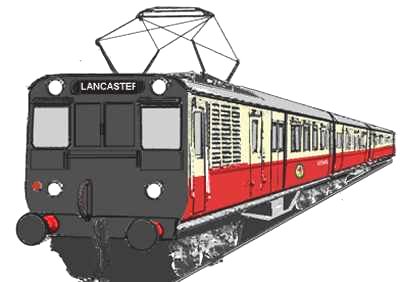
The sketch is based on a photo of one of the 1953 AM1 sets (converted LNWR units, dating back to their original London 630v DC electrification in 1909 and held in storage since 1940). The photograph, taken in the mid 1950s, is black and white but the unit appears to be in BR crimson and cream livery with the coach roundel on the driving coach only. In the mid 1960s at least one unit was repainted green with a rectangular yellow panel on the lower part of the driving cab front.
'Chippy', a regular on the uk.railway newsgroup was able to advise -
One of the units was brought to London at the time that the conversion
from DC to AC was being considered for the Liverpool Street and
Fenchurch Street lines. It carried out tests on a curve off the
Fenchurch Street line that was specially isolated from the rest of the
system, and temporarily energised with AC current during night-time
possessions. It thus became the first AC unit to operate on the
Eastern Region.
There isn't a lot on the web about the Heysham system - the best and most
informative seems to be:
http://glostransporthistory.softdata.co.uk/electrif.htm
Class 302 (originally AM2)
A 4 car London Tilbury and Southend EMU Originally built in 1958-59 for the BR standard 25kV and 6.25kV 50Hz ac overhead operation. It was thought that the lower voltage would allow smaller clearances in tunnels and the like but the sets were later converted to 25kV only (6.25kV remained in use in some areas until 1983). Four sets were modified for Royal Mail use in the early 1990s, fitted with roller shutter doors and painted in the red and yellow Royal Mail livery.
Fig___ Class 302 EPU
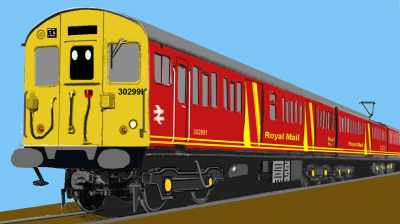
The sketch shows a converted unit, there are two roller doors on the lead coach as this had a toilet block separating the first class section (behind the cab) from the second class section (toward the inner end of the coach), the remainder of the coaches in the set have only a single roller shutter door. As high density units these originally ran with seats arranged back to back and doors between each pair of seating units, resembling an all compartment coach although the interior was open not compartmentalised.
The remaining 302 sets continued in use on the London Tilbury and Southend until 1998, when LTS Rail replaced them with some slightly younger Class 317s.
Class 303 (originally AM3)
These 3 car Scottish Region EMUs were introduced in 1959-61 and equipped to run on either 25kV or a reduced voltage of 6.25kV (which allowed smaller clearances). The 6.25kV supply proved problematic with switching surges damaging the transformers and 303 fleet and some of the GE/LTS London fleet had
to be taken out of service for extensive repairs (the last 6.25kV supplies were changed over to 25kV in 1983). When new the 303s had a three pane front glazing, the outer panes being curved to wrap around to the sides (the 'wrap round' window was fashionable at the time on motor vehicles). By the later 1990s on at least some units the wrap-round pane was replaced by a metal sheet with a small flat pane window set into it (see Class 311 below). When new they sported a livery of Caledonian Blue (and were known as the Blue Trains thereafter) but were subsequently painted in standard BR blue livery. In the mid 1980s some were rebuilt and repainted in Strathclyde orange livery (see Class 107 DMU), and in the 1990s the new red and cream Strathclyde livery was applied. From the mid 1970s some of these units were transferred to the London Midland Region for operation in the Crewe-Liverpool area and some (I believe) retained their Scottish livery. I believe they were all phased out of service by about 2002.
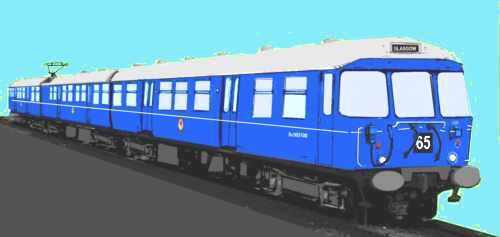
The sketch shows what I believe was the original 'Blue Train' livery. The two digit headcode box was later plated over and in the 1980s this area had a high intensity light box mounted on it. 65 indicates a service to Springburn. The passenger windows had either four-section sliding upper lights, as standard on BR Mk 1 stock, or windows hinged along the bottom edge, I have found photos of both types.
Class 304 (originally AM4)
Introduced for the electrification of the West Coast Main Line in the 1960s, starting around Manchester and making their way South to reach London by late 1965. Originally 4 car units they were shortened to three cars in the 1980s. When new a small number were sent to Eastern Region for the Shenfield-Southend route to cover for stock shortages pending the arrival of new stock. Visually I could not tell the difference between a 304 and a 305 unit, the front was identical but although there may have been some slight variations in internal layout when I used the South Manchester services a lot in the 1970s and 80s (when both types were in service) I never noticed any differences. They were replaced by Class 323 units in the mid 1990s.
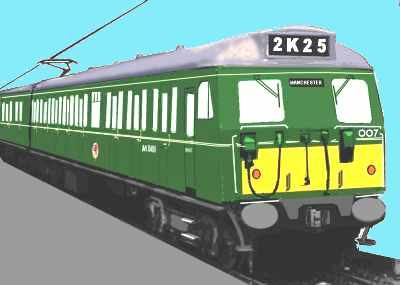
The sketch shows the livery used in the early to mid 1960s prior to the introduction of the BR corporate blue livery, introduced over time after 1967.
Class 305 (originally AM5)
These 3 car EMUs were built for services in the North East of London as 25kV/6.25kV electrification was introduced in the 1960s. Later they were transferred to other areas, notably Manchester (operating from Piccadilly) and some ended up in Scotland on the Edinburgh-North Berwick line. All were withdrawn by late 2002.
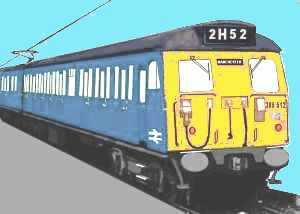
The livery shows is the BR corporate blue introduced in the later 1960s, the sketch was based on a photo dated 1971 when the units had not yet received the high intensity headlight in the centre of the front. 2H52 and 53 were the services between Altrincham and Wilmslow (alternate services running via Styal and Stockport). The 305 units appear to have had their full six digit number shown on the front, the 304s only ever seemed to have the last three digits displayed in this way. By the time of withdrawal they were wearing Regional Railways livery.
Class 306 (originally AM6)
An LNER designed 3-car set ordered just before Nationalisation for the London Liverpool Street-Shenfield route. Following the lead set by the LMS these units had pairs of pneumatically operated double doors in the sides but with passenger operated push button controls. As built the sets were fitted to operate at 1,500V dc from the overhead, the double-diamond type pantograph was mounted at one end on a cut away section of roof above one of the driving cabs and guards compartment. They were changed to 25kV (or 6.25Kv for inner London) overhead operation as the new system spread around London, the roof at the pantograph end was built up to normal height and a new cut-away carrying a BR standard arm-and-elbow pantograph was added to one end of the centre car. The change must have occurred before 1967 as the rebuilt units were still in BR Green with the roundel emblem on the coach sides (when new they bore the lion on wheel logo as shown in the sketch). They were replaced by Class 315's in the mid 1970s.
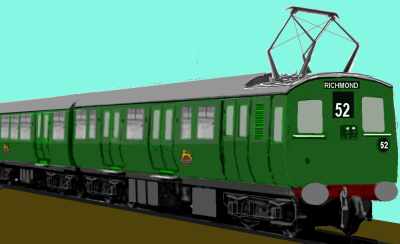
Josh Hamilton was kind enough to point out several errors in the illustration and associated text - Originally the units used a 5-lamp headcode indicator, the sketch shows a unit with a 2-digit headcode box but these were fitted after conversion to 25Kv (6.5Kv for units operating in inner London)- The circular disk under the drivers cab window is the number allocated to that unit, both are shown on the sketch but the metal disc was not present on the units with the large central roller-blind route indicator. Richmond as a destination is wrong as they only operated between Liverpool Street and Shenfield.
Class 307 (originally AM7)
A series of 4-car sets built for the line from London to Southend, when built they used 1500v DC overhead supplies but as the 25kV system spread in the 1960s they were converted to use this instead with a switch over facility for 6.25kV used in the inner London areas. The 307 units were identical to the Class 308 units illustrated below but the cab front was much more Southern and 'flat fronted' (actually the front was three panels, the outer two being angled back slightly). They served in BR Green, BR Rail Blue, BR blue and grey and Network South East liveries. In 1990 a few were sent to Leeds for local services and repainted in West Yorkshire PTE red and cream but they were soon replaced and all were withdrawn by 1993.
The sketch shows a unit in NSE livery.
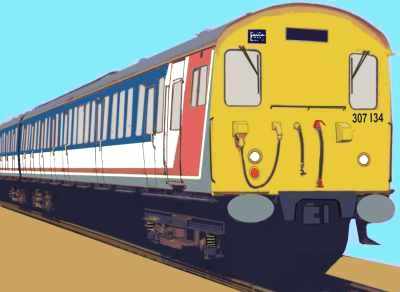
Once the 307 sets were withdrawn some of the end cars were refurbished for use as Propelling Control Vehicles on Royal Mail trains, TOPS coded NAA. New sides were fitted, equipped with two roller shutter doors, the old jumper cables and destination roller blind were removed and new light clusters fitted. These units worked with Class 47 locomotives modified to operate in push-pull mode with the intermediate vehicles being RES roller shutter vans or even travelling post office vans depending on the service in question. These trains were operated by RES and painted in RES livery. RES painted the upper ends dark blue grey and used their standard livery on the sides. In 1996 EWS purchased RES and repainted the stock in their own livery, the sketch shows EWS number 95300, the lettering at the far end is EWS.
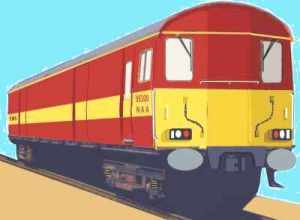
EWS lost the mail contract in 2003 (controversially and apparently after the Royal Mail took advice from a rather dubious set of consultants). In 2005, following a trial in 2004, GB Railfreight won a contract with Royal Mail to start limited mail services again. EWS still handles parcels and mail traffic for other companies (notably DHL).
Class 308 (originally AM8)
Introduced in 1960 for use on the former Great Eastern lines (the class were sometimes known as Clactons as that was one of their main destinations). They were identical to the AM7/Class 307 sets but with a redesigned front incorporating a roller indicator panel and some sets included a full luggage van (which had the pantograph on one end). As with the 307s they were capable of running on either 25kV or a reduced voltage of 6.25kV which allowed tighter clearances on the London end of the line. The 308 units were delivered in BR Green livery, changing to BR Rail Blue in the later 1960s. They were refurbished in the 1980s and repainted in Network South East livery but then moved to West Yorkshire operating from Leeds in the early 1990s where they were repainted in West Yorkshire PTE colours of maroon and cream. By this time (possibly after the 1980s refit) they were three car units and the Motor Luggage Van had been removed, the centre car carrying the pantograph was a standard passenger vehicle. I believe they were all withdrawn by 2001.
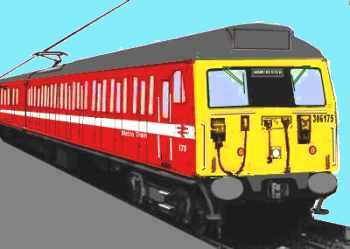
In the later 1970s the 308s were being replaced by the new Class 312 sets and in 1983 three of the 308 units were converted for parcels work for use on the line to Tilbury docks (something to do with cruise liners apparently), the 'motor luggage van' was retained and the 'driving trailer' converted for parcels work (as with the DMU conversions at this time it may simply have been a matter of removing the seats). These units were withdrawn when the Class 302 parcels units, with roller shutter doors, arrived in the later 1990s.
Class 309 (originally AM9)
Introduced in 1962 for operations from Liverpool Street on the former GER lines and when built they could operate on either the full 25kV or 6.25kV (used on inner suburban lines). They were supplied in four, three and two car units. The pantograph was mounted above the guards compartment, on two car units this was behind the drivers cab at one end, on three and four car units it was on an inner car toward the centre of the train. By the time these units were delivered BR had settled on the 'arm and elbow' pantograph and these units were fitted with that type from new. One small point to note is that the 'elbow' was toward the end of the coach (usual on EMUs) but in the case of the two-car 309s this put the pantograph the opposite way round to that on the contemporary electric locomotives. Rich Mackin was able to advise- Out of the units built under BR, only the Class 309s 'Clactons' wore maroon, as they were originally intended as 'Intercity' units, intended for London-Leeds(!) services under the original ECML
electrification plan of the 1960s. They were designed for 'express' services and were the first EMUs to offer a top speed of 100 mph. Originally painted in maroon they then went though the changes to BR Blue and Network South East. In the 1970s additional coaches were added, adapted from Mk 1 loco hauled stock. In the mid 1990s they were withdrawn but a few were sent to the Manchester area where they operated as three car sets until withdrawal in about 2000 (most still in NSE livery I believe but one set was repainted in Manchester Airport aircraft blue promotional livery). The front is actually fibreglass and uses the same design as the Trans Pennine Class 124 DMU, although that unit did not have a gangway door (some of the 309s may have lacked the gangway door as well but I am not sure about that)
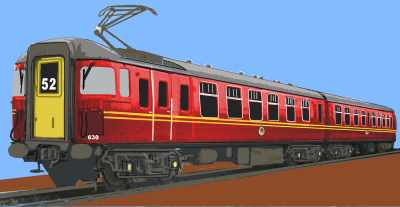
The sketch shows a two-car unit in original maroon livery. The wrap-round cab windows were progressively replaced with a sheet metal insert fitted with flat front and side windows (see also Class 311 below). I believe the last wrap round windows were seen in about 1980. As electrification spread in the east in the 1980s these units reached as far as Norwich, their high speed design offering similar timings to loco hauled express trains. When the new Class 321s arrived in the 1990s a few 309s went to work in the Manchester area, I believe the last were withdrawn in about 2000.
Class 310 (originally AM10)
The following information was supplied by 'Ian' and Rich Mackin both of the uk.rec.models.rail newsgroup (see App 6 Contributors and Bibliography).
First introduced in 1965, about fifty sets were built over about two years. These units were visually very similar to the later Class 312 units (illustrated below). Initially they were the mainstay of the
Euston-Northampton-Birmingham services, the units were based at based at Bletchley (BY), in 1987 one set (310052) was transferred to East Anglia and based at Ilford (IL). By the end of the year many other Class 310s joined it, but they transferred en mass back to BY in 1988, leaving only 310084. In 1989 a few units trickled back to IL, while others were transferred to Fenchurch Street-Tilbury-Southend workings, displacing aging Class 302s at
EM (East Ham). Later that year, BR re-organised them into Class 310/0 and
Class 310/1, the latter being fully declassified to Standard Class for
Provincial Sector/Regional Railways in the West Midlands. These units lasted
until 2000, seeing in the privatised era with Central Trains. The earlier
Class 310/0s continued to work on LTS/Great Eastern services until 1991,
when they were concentrated on LTS services. The Class would see it's final
days here, the last examples being withdrawn by c2c in 2001.
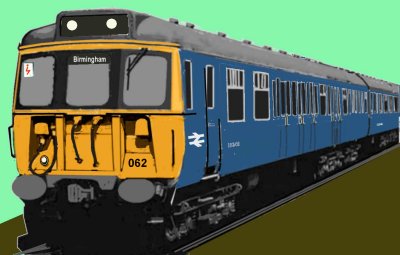
The sketch shows a unit photographed in 1979 in plain blue livery.
Class 311 (originally AM11)
These units were ordered to beef up the stock on the south of Glasgow lines. They looked identical to the earlier class 303 (sketched above) and were supplied in the then standard BR Rail Blue livery with full yellow front. I believe they changed to blue-grey livery and may have had the early Strathclyde orange and dark grey livery before being withdrawn in 1989.
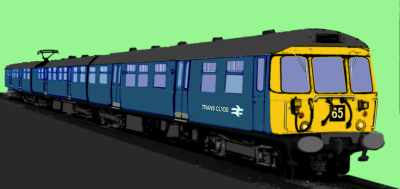
The sketch shows a unit in BR blue livery with Trans Clyde branding from a photo taken in the late 1970s. On this unit the curved wrap round windows have been replaced by metal plates with a smaller window set into the front (see also Class 303 and 309 above)
Class 312
Built in the mid 1970s (all withdrawn by the end of 2004) these 4-car units were built to operate on the recently electrified Great Northern line from Kings Cross and on some outer suburban lines. They were built to operate on either 6.25kV or 25kV supply, the lower voltage was added as it was thought it might reduce clearances in tunnels and the like but in practice I understand 6.25kV was never used on this line (I could be wrong on that point). In later life all these units were converted to 25kV only and in the 1980s a small number of these units sent up to the Birmingham area where they got a blue and yellow paint job (but they soon returned to the Greater London area). Eventually all variants got the standard Network South East livery and later the privatised train operating company liveries. Some operated on the former London Tilbury and Southend line, where they were replaced by Class 357 Electrostars (introduced in 2000).
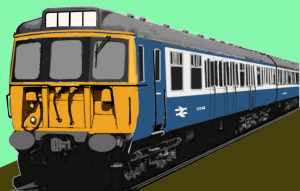
The sketch shows the original as-delivered blue and grey livery.
Class 313
Able to use both overhead and third rail supplies these aluminium skinned units were something rather new when they appeared in the mid 1970s for use in the London area. They have the 'Scharfenberg' combined buffer-automatic coupler as used on the later Class 14x series of railbus and hence do not have buffers or the electrical cables and hoses used on earlier designs. It is perhaps worth noting that the basic design, two pairs of pneumatic doors on each side and flat fronted dates back to the LMS Liverpool third rail multiple units of the 1930s (BR Classes 502 and 503). These units are genuinely flat fronted however and lack the subtle styling of the LMS design. This same basic body design has been seen many times on BR era stock, notably Classes 314/315/507 and 508. As with the LMS units on the Wirral lines the British Railways safety people required these units to have a central escape door at each end because they often run in tunnels, although these units had them from the start. Some units were upgraded in the later 1990s and I understand they remained in use for several years after that.
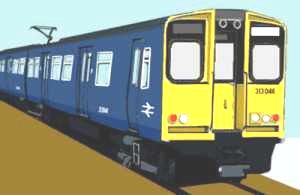
Class 314
Introduced in the early 1970s for the services operating out of Glasgow these aluminium skinned units very closely resembled the Class 313/315 and Class 507/508 sets. In the early 1980s they were repainted from BR blue to Strathclyde orange, in the later 1990s this changed again to Strathclyde maroon and cream.
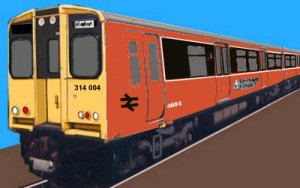
Class 315
Introduced in the 1980s as replacements for older classes in the London area, these units had pairs of pneumatic sliding doors in place of the old style 'slam doors'. Delivered in BR blue they have since changed to Network South East and then privatisation liveries. Very similar in appearance to the earlier 313 units illustrated above. The sketch below shows the Wagn livery.
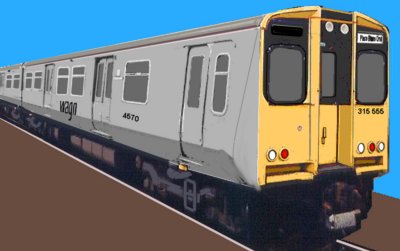
Class 316
This was (I believe) a heavily modified EMU driving coach forming part of the Class 316 Holec traction equipment test train.
Class 317 LMR/ER London Suburban
The introduction of this class of 4-car sets in 1981, designed for driver-only operation, brought all sorts of problems with the unions which caused a series of delays. They were for use in the London area serving the outer suburbs, specifically the Bedford-St Pancras commuter service and the carriages were based on the BR standard Mk 3 coach.
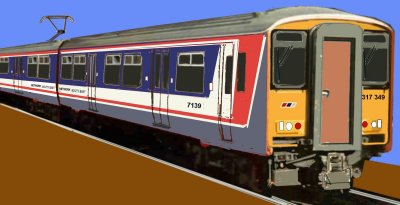
In about 2000 a small number were modified (mainly by removing some seating and fitting additional luggage racks) to operate on the Stanstead Airport rail link service. These modified 317 units had new lighting clusters, replacing the original rectangular boxes on the cab front.
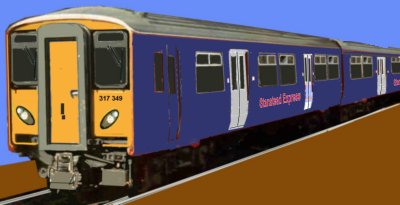
Class 318 ScR Ayrshire Suburban
These units were built in the 1980s for use on the lines around Glasgow. Although based on the class 317 design and using the same BR Mk 3 EMU body design it is perhaps worth noting that the similarities between the class 318 EMU and the class 156 DMU are evident when they are seen together.
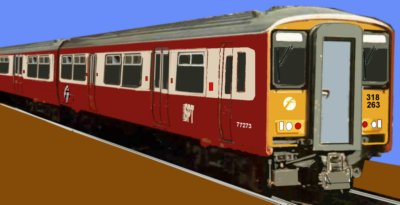
Class 319 Cross London (Thames Link)
These four car sets, introduced in 1988, are dual-power able to use 750V DC third rail and 25kV AC overhead supplies. They have the same Mk 3 EMU bodu shell as the Class 317 and 318 units and due to the lengthy tunels on their intended routes they were required to have escape doors set into the ends. These doors are not fitted with coridoor connections however, so these units cannot form a single walk-through unit if worked in multiple. They saw BR 'Network South East' livery and subsequently were repainted in privatisation era 'Thameslink' liveries, the example shown is not the most colourful variant but was the easiest to draw. The mid 1990s saw what was called the Thameslink 'grafitti livery', a multi coloured affair of odd shapes. The most recent version of the Thameslink livery (c2005) has a light grey body, blue cab sides and blue around the windows, except for the first class compartment which has a yellow window surround. The units were refurbished at the time this livery appeared.
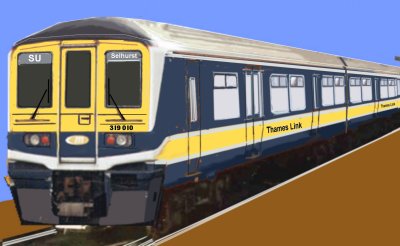
In the mid 1990s a few Class 319 units were converted for parcels work and reclassed as 325 (see below), loosing the emergency evacuation door in the front of the cab as part of the conversion but retaining the dual voltage capability.
Class 320 - ScR Glasgow Suburban
These 1980s three car units are cloesely related to the four car class 321 and 322 units, and the two-car Class 456 units. The sketch shows the 320 unit in the original 1980s Strathclyde orange livery, in the 1990s the new red and cream Strathclyde livery was applied as shown on the Class 318 unit above.
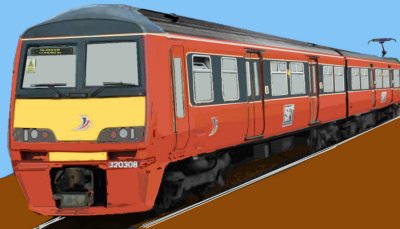
Class 321 - ER/LMR Outer Suburban
These flat-fronted four car units were introduced in 1987 and have been used by several companies, the photo shows an example in Silverlink County livery (this company operates services between London,
Bedford, Milton Keynes and Northampton). London and Leeds have four-car versions in service. They appear to be very similar to the three car Strathclyde Class 320 units, the only difference seems to be the provision of door opening buttons on both sides of the passenger doors.
Fig___ Class 321
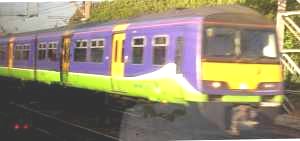
Photo courtesy Sara Dee.
Class 322 Stansted Airport
Class 323 - Regional Manchester &Birmingham
Introduced in the mid 1990's to replaced the elderly Class 304 units in the North West.
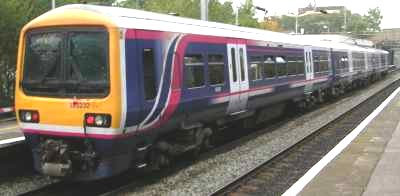
Class 325
Introduced in 1995 these were new multi-voltage electric non passenger carrying four-coach units were introduced to carry mail between sorting offices. They were based on the Class 319 dual-power (750V DC third rail and from 25kV AC overhead) design but built specifically for parcels work with large roller shutter doors in the sides and no emergency escape door in the cab front.
When RES was bought by EWS they continued in service painted in Royal Mail red livery on the West Coast Main Line service. In 2003 the Royal Mail decided to stop using trains for letters and cancelled their contract with EWS, this proved to be a bad move and in 2004 they ran a trial with GB Railfreight, followed in 2005 by a contract to run a series of mail trains which I understand use these units. The sketch below was made from a photograph taken in November 2005 (from a moving Pendolino, hence of poor quality) of a four coach unit covered in graffiti on a siding north of Stoke on Trent. These units have buffers but what appear to be buckeye couplers and could operate in multiple but I believe the rake was always made up of four coach sets. The four coaches each have two doors per side but the only windows seem to have been on the cab fronts and cab side doors. The yellow marking at the inner ends of the end coaches and both ends of the inner coaches is the royal cipher (EiiR surmounted by a crown). Curiously these units do not appear to have had the yellow diagonal stripes added to their doors.
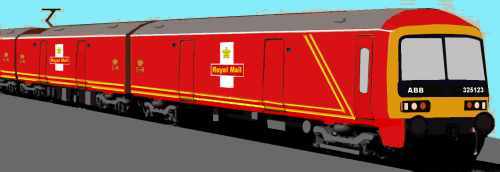
Class 332 - Heathrow Express
These are almost identical to the Class 333 shown below but lack the side mounted destination indicators.
Class 333
These units operate in the Leeds area, they appear to be identical to the Class 332 units, although presumably the interior fittings will be different with less luggage space.
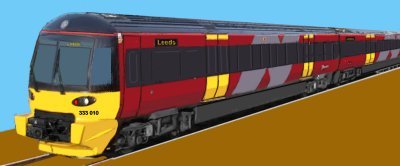
Class 334 Juniper
Built by Alstom and introduced in about 2001 for Scotrail, they were supplied to Strathclyde PTA and originally painted in their livery, as shown in the sketch below.
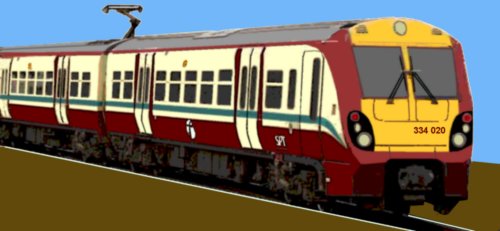
Class 350 (Desiro)
These are WCML units, the sketch shows the Central trains livery from a photo taken at Birmingham New Street. Same coaches as the South West Trains Class 450
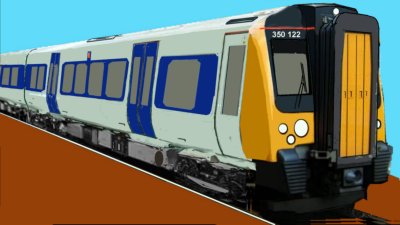
Class 357 Electrostar
Ordered by LTS rail in 1998 to replace aging class 310 and 312 stock in use on the London, Tilbury and Southend line. Considered a great improvement on the elderly units they replaced (which were older than most of the passengers). The sketch shows a unit carrying c2c livery in 2002.
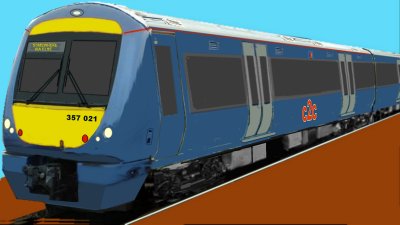
Class 360
Four car units in the Desiro range, often seen in the flowing livery of First Group (see Class 323 above) the example shown is on Heathrow Connect duties.
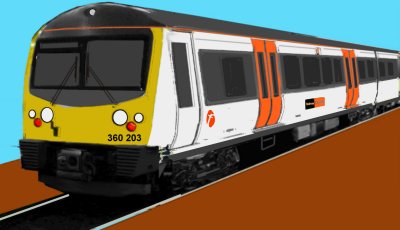
Class 365 Networker
These were intended to be dual-voltage versions of the aluminium bodied Class 465 (illustrated below), in the event two lots were built, one for 25KV the other for third rail, both could be converted to dual voltage but (I blieve) never were. The units were built by ABB and used on former Great Northern lines under 25Kv and for Kent suburban services on third rail power.
Class 370 APT
The BR technical people developed the idea of a train that tilted or banked when going round corners, allowing a 20 percent increase in speed on the bends. They got as far as building a gas turbine powered prototype (APT-E) and some pre-production 25KV units for evaluation (APT-P) but the project was then cancelled after a number of technical problems were identified and the government felt it was too expensive to fund the exercise further. The photo below shows the APT-E, scanned from BR publicity material.
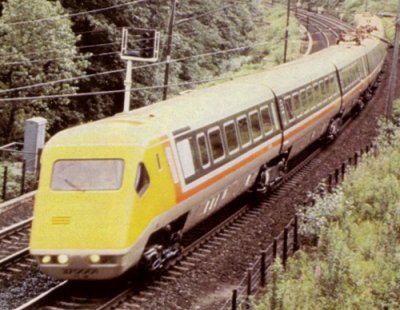
Others took up the idea however and several countries now operate units of this general type. When Virgin Railways wanted tilting trains they were able to arrange a licence to use the Italian (Fiat) system for their Pendolino units.
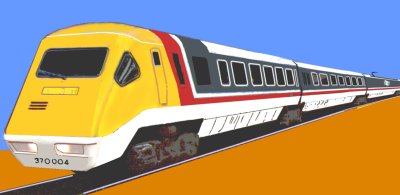
Class 373 Eurostar
These units handle passenger trains running city to city via the Channel Tunnel, at each end there is a power car, and the attached passenger car is also partly occupied by power and control systems. The centre coaches are articulated.

There was a plan to operate these trains beyond London, providing connecting services direct to Europe but that plan was shelved and UK services terminate in London. The sets intended for the UK provincial services were shortened and some have been leased to GNER for use on their Kings Cross to York services, these were repainted in GNER livery.
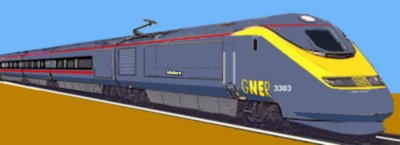
Note the liver used by GNER seems to have changed over time, particularly in the size and placement on the GNER logo on the power car.
Class 375 and 376 Electrostar
These units are dual power, able to run on either third rail DC or overhead 25kV AC supplies. These have a rather distinctive appearace thanks to the coridoor connection on the front of the driving cabs. The sketch shows a Central Trains livery, in use in 2005 and shows the end with the first class compartment (indicated by the words first class on the side and the yellow stripe at the cantrail)
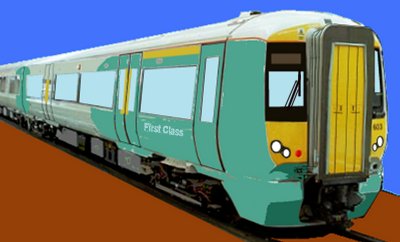
Class 377 Electrostar
Third rail modern units for use in the London area, very similar to the 375 and 376 but these units have additional ventilators just below the cantrail on the upper sides. The sketch shows the livery used in 2005.
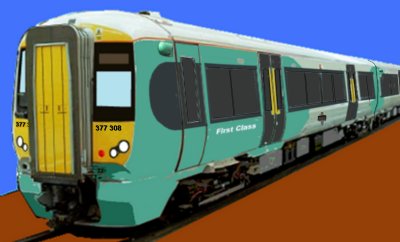
Class 390 - The Virgin Pendolino.
The Pendolino tilting trains were built in Britain by Alstom but use the Italian Fiat tilting mechanism. Introduced for the West Coast Main Line in 2002 they have a top speed of 225 kph (140 mph), but will be limited to 200 km/h (125 mph) on the West Coast Main Line pending improvements to some of the curves. When introduced the first thirty or so sets were built as eight car units, subsequent sets all have nine cars and the early sets had a ninth car added by 2004. The Pendolino sets handle all the Virgin WCML traffic from London, via Birmingham to Manchester and Glasgow. They also operate on non electrified lines, hauled by modified Virgin Class 57 diesels, currently from Crewe (where the 57 is attached) to Hollyhead on the North Wales coast line.
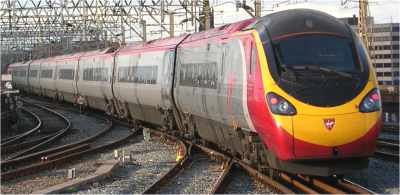
The Pendolino sets were purchased to replace a mixed fleet of Class 86, Class 87 and Class 90 locomotives which operated in push-pull mode with rakes of BR Mk 2 and Mk 3 coaches. The class 83 locos went back to the leasing company in 1983, the 90's in 2004 and the last of the 87s in 2005. All have now been transferred to duties with other companies, although the Class 86s may be withdrawn altogether in 2005.
London area DC EMUs
The first of London's electric trams ran in 1901 and tram services soon began offering competition to the railway company services. Electric trains were already in use on the sub-surface lines (the first experimental four-rail systems were introduced in the 1890s) and the electric train, with its rapid acceleration was seen as the answer to the tram. EMUs used in the London suburban area included LBSC (6.7kV AC overhead supply services starting in about 1909, converted to third rail in about 1929), LSWR (600v DC third rail, starting in about 1913 following the lead set by the 1904 L & Y Southport line) and LNWR (the LNWR started out with a 630v DC four rail system which began operating just after World War One). The SECR had a plan (established in 1903 and based on 1500v DC overhead supply) but this was not implemented until the SR era, by which time the third rail system was standardised. The LNER electrified some former GNR and GE lines using 1500v DC overhead supplies, these were later changed to the BR 25kV system. The GWR had a link to and working arrangement with the Central London line underground service based on the Ealing and Shepherds Bush Railway scheme which allowed GWR freight to access inner London and Central London line underground trains to access suburbs (power was supplied by the GWR power station at Park Royal). The GWR did operate 'workmens trains' on this line, using specially built narrow bodied four wheel coaches, but as far as I can find these were steam hauled and they did not operate electric stock themselves.
The Southern Railway opted to standardise on the LSWR third rail system but using 660v DC, converting some of the older lines and extending the network well beyond the suburbs over the years. The LMS (former LNWR) lines retained their four-rail system (as has the London Underground, these North London surface lines changed to three rail in the 1970s. When BR first looked at main line electrification (using a proposed 1500v DC overhead system) in 1948 it was decided that the three (and four) rail systems already in service (in the North East and North West as well as in the London area) were already so extensive and established that changing to overhead would be uneconomic. The Southern Region of BR did however increase the supply voltage to 750v DC in the early 1950s (except on the North London Line which remains 650v). There have been some units built that can operate on both overhead and third rail supplies, notably the Class 313 EMU discussed above, but in general the London suburban third rail system exists in something of a world of its own.
Listing the SR and constituent EMUs is difficult as the commonly used 'Southern' designations such as 4-SUB and also the BR era Class numbers were descriptive of the type of unit, in this example a four coach suburban unit, or of the braking system fitted. This designation does not indicate the make or model of the equipment and in some cases units of distinctly different origins and design received the same identification (such as the purpose built SR 3-SUB units augmented by converted LSWR stock). One has to dig rather deeper to clarify these elements in pre-BR units. The reader is recommended to look for detailed information on the more specialised sites such as Southern Electric Modellers Group for SR era stock and The Railway Centre dot Com for BR era stock.
Note it was standard practice to operate the following sets in multiple, for example two 3-sub (three coach suburban) sets operating as a six coach train.
Livery Notes
The livery on the SR EMUs is not something I know much about, these notes are based on material found on the internet and may contain errors. I believe that a red buffer beam was a requirement on all locomotives prior to the introduction of the yellow panel in the 1960s (dating back to an earlier rule requiring a man with a red flag to precede all locomotives on the move).
There are I understand two basic periods of SR livery, defined by the CME, first was R. E. L. Maunsel (CME of the S.E.C.R. from 1913) who ran things from 1923 to 1937. He was followed by O. V. Bulleid (who had been the assistant to the LNER's Gresley) who was the SR CME from 1937 to 1947.
I believe the basic body colour was originally Maunsel green, fully lined and with a large (about a foot high) number 3 or 1 on the doors to indicate third and first class. The class numbers were in (I believe) white with a red drop shadow. The four digit unit number was in white on the upper front, repeated in white shaded red on the upper sides near the ends. There is a motor driving trailer in the NRM bearing this livery. The word SOUTHERN appeared about half way along the body side in white
Under Bullied the colour darkened and lining appears to have been discontinued. I am not sure about the class numbers on the doors during this era, the only photo I have found was of a 'heritage' unit repainted by BR which did not have these numbers in place. The word SOUTHERN was now in yellow and shaded (this was called 'sunshine' lettering, I think the shading was red, it may have been black)
Under BR the body colour changed to Brunswick green (although some units were painted in maroon I believe), first class was indicated by a yellow stripe at the cantrail and from the photographs I have so far found no lining was applied. The BR coach roundel was applied to the sides. From 1962 small yellow panels appeared on the front of units, becoming a full yellow front by the 1970s. After 1967 the logo changed to the BR double arrow and the body colour changed to BR blue with non-suburban units having a grey band at window level. Curiously the grey band was carried right to the end, not stopping at the drivers door as on DMUs, this may have been because these units so often operated in multiple. In the 1980s units transferred to other areas received the local 'Passenger Transport Executive' livery and of course since the late 1990s the privatisation liveries have appeared.
Some units in the early BR era had an orange V painted on the cab front at the end where the luggage compartment was located, there to assist staff handling the luggage I believe. This marking was I understand standard on the DEMU stock running to the coast but I am not sure if it was applied to EMUs. During the BR small yellow panel era the orange V was replaced by a black triangle and this was applied to at least some of the 2-BIL stock.
Southern Railway 660v DC and 750v DC EMUs
The original SR designed EMUs were based on the existing LSWR units, they retained the 660 volt DC third rail supply which the LSWR had introduced in 1913. Under the SR the electrified lines were divided into three sections, eastern, central and western, with units commonly assigned to a single section (often later being made common user for all sections as newer units came along). Western section required 57 foot units, eastern and central could handle units just over sixty feet long. I believe the SR built the units at their own works. Demand for EMU services proved strong and additional units were built by converting older passenger coaches and existing EMUs from the absorbed companies (LBSCR, LSWR, SECR and even some LCDR six wheeled five compartment coaches converted to four wheelers with the end compartment set aside as a driving cab with a full width three pane window across the end). The conversion of older pre grouping stock continued into the later 1930s and old EMUs were often used to supply parts for later models, ranging from complete underframes to all the electrical equipment.
3-SUB and 4-SUB
The 3 car suburban (3-SUB) sets were introduced 1925, early batches were built as new, later batches were rebuilt LBSCR steam passenger coaches. The LSWR conversions are illustrated below, showing the motor coach on the left and the driving trailer on the right.
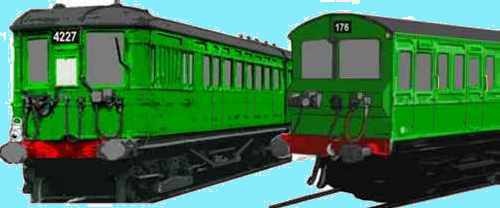
In the 1940s some units were converted to four coach sets and the 4-sub was the most common SR built EMU type. Both the 3-SUB and 4-SUB sets were classified by BR as Class 405 although I suspect the survivors were probably all SR built rather than converted stock (I could be wrong on that). I suspect that later examples built by the SR may have been to a different design than the 1925 stock, they appear to have more of a 1930s styling to them although the 'toplights' (small windows) above the door windows hark back to earlier designs. All the examples I have found photographs of were compartment coaches, complete with the mirror and the promotional watercolours on the dividing walls. I am not sure if these units had red buffer beams but that seems to have been standard practice, the end units had standard screw link couplings and buffers.
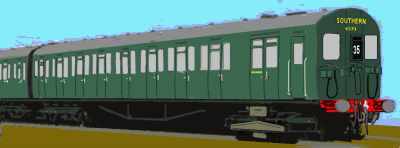
I am not aware of any kits being available for either the converted LSWR stock or the SR built sets but there was an excellent article in the N Gauge Society Journal 6/05 by Arthur Adams on converting Farish 'suburban' coaches to model both types with a Farish motor-bogie 'hidden' in the guards compartment. The resulting models do capture the look of the prototypes rather well.
2-WIM & 2-SL
Introduced in about 1930 these were converted LBSC EMU cars (illustrated above and originally built just before the First World War). The conversion seems to have involved simply removing the overhead pickup and fitting third rail pickup, the full-width single character route indicator was retained. The WIM suffix indicated units for use on the Wimbledon line, SL indicated 'south London' lines. All were withdrawn in the early 1950s when they were in green livery with the BRITISH RAILWAYS text logo.
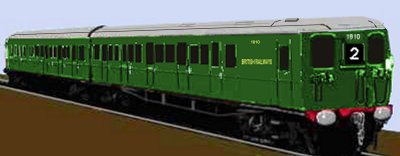
2-BIL
Introduced 1938, became BR Class 401, withdrawn mid 1970s. These were SR designed semi-fast units used for non suburban services. One unit was taken over by the Derby research team and used as a testbed, I believe it was still in BR green with small yellow panel and was loco hauled in this duty.
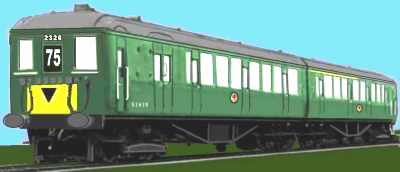
The sketch shows the set in mid 1960s livery, following the introduction of the small yellow warning panel on the front. This is the basic livery that unit 2057 was wearing when sent to the RTC for experimental purposes. The black triangle indicated the end at which the luggage compartment was located, this was apparently added to 'assist staff', the yellow panel at the other end being plain. I am not sure if this marking was applied to all the 2-BIL units, or indeed how widespread this marking was, although it was also used on the DEMUs Classes 205-207. A single 2-BIL unit has been preserved as part of the National Railway Museum collection.
2-NOL
The 2-NOL two-car SR semi-fast units were produced in 1934 by converting some LSWR compartment passengers coaches.
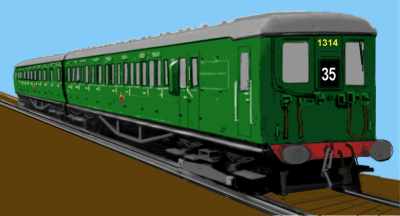
2-HAL - Introduced 1939, became BR Class 402, withdrawn 1971.
These SR designed semi-fast units were the follow on to the 2-BIL type but with flush mounted windows. Fitted with standard screw link couplings (at the outer ends at least).
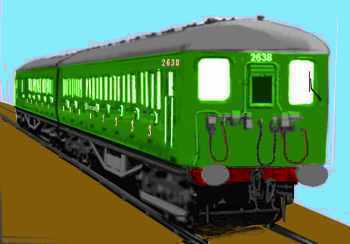
The post war version had a flatter front end (the sketch shows an SR example). The livery as shown is plain SR light green with large number 3's on the third class doors and 1's on the four first class compartments, the numbers on the doors and the set number on the upper side are white shaded red, the set number on the front is white. The word SOUTHERN is in white about half way along just below the window line.
5-BEL 1932 Brighton Belle sets, became BR Class 403, withdrawn in 1971
Brighton Belle sets, built in 1932 and run in Pullman umber and cream livery. They were the first all electric Pullman cars in the world. Only three sets were built, each of 5 cars, usually running as two sets in multiple.
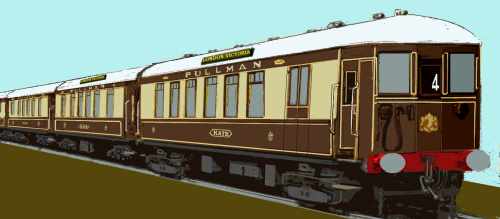
In a thread on the uk.railway newsgroup relating to the economics of running trains Peter masson commented . . .
One suggestion has been that trains should be fitted with meters, to measure
the actual traction current used and have the TOC billed accordingly. This
is not entirely unprecedented - when the Brighton Belle and the 6PUL
Brighton line sets were built, they were fitted with meters, so that the
Southern Railway could bill the Pullman company for the electricity, from
the traction supply, used for cooking in the Pullman kitchens.
They continued in this livery until the later 1960s when they were repainted in BR Pullman blue-grey livery. This was rather insipid by comparison, the individual car names were replaced by 'Brighton Belle' and the sets looked rather slab sided in this typically bland 'corporate' colour scheme.
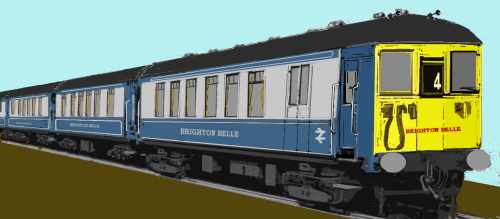
The quality of service was reputedly maintained to a very high standard even under the BR 'Corporate' regime and I remember there was quite a fuss when they were withdrawn.
4-COR, 6-COR, 4BUF, 4RES, 4GR, became BR Class 404, withdrawn in the early 1970s.
The 4-COR sets (made up of four corridor coaches) were first delivered in 1937 for the newly electrified Portsmouth line and often operated in multiple. I have seen references stating that these units had no end gangway connections however all the photographs I have found show the gagngway present. I do not know if this was a later modification or if they were built like this. The four car RES sets were built to provide full restaurant facilities from 1937. The BUF and GRI sets were conversions of the RES sets in the early 1960s. They were used on other lines from the 1960s on as more modern stock appeared and were withdrawn in the early 1970s.
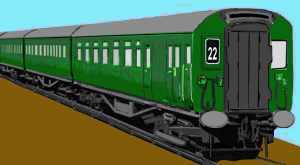
They were slightly unusual in that the two digit route indicator was located in the 'spare' window in the driving cab, on the other side of the corridor connection from the driver (on the left when looking at the end)
4-DD
Two four-car double decker units designed by Bullied and introduced in 1949.
These units were built to try and maximise the passenger capacity on a line where lengthening the platforms was considered too expensive. They had to be built to the full size of the loading gauge and had the upper and lower compartments staggered (so the feet of the people above were above the heads of those below and the headroom in the lower deck was under the seats of those above). This resulted in a very distinctive window arrangement along the sides of the coaches with the lower compartments having a large window in the door flanked by small windows by the seats and the upper compartments having a large central window again flanked by smaller windows above the seats. They were I believe the first coaches to use fluorescent lighting and had to have air conditioning as the windows could not be opened (due the safety concerns because of the tight clearances.
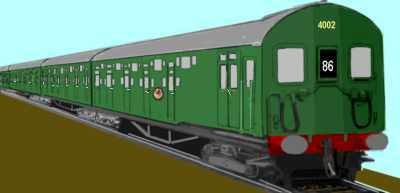
In use it was found that the time taken to get people on and off through the limited number of doors and up and down the narrow staircases meant that journey times were increased, and the public did not find the rather dimly lit interior terribly enticing.
They survived into the Corporate Blue with full yellow ends era (although in 1970 at least one still had green sides), but were not considered an unqualified success and were scrapped in 1971.
BR Classified 750c DC EMUs
BR inherited a large and mixed fleet of former Southern Railway 660v EMUs at Nationalisation however many of these were in a poor condition after the hard years of the 1930s and the Second World War. BR decided against changing over to and overhead supply in the London area but they decided to increase the supply voltage to 750v. Just to complicate matters in some cases BR built sets using their own body designs to supplement SR designed units but retained the same class number for both. This area is complex and as it is not an area I have a personal interest in this sub section may contain errors. I have tried to identify the more interesting prototypes but the compilation of a simple 'know your enemy' chart has so far proved impractical and the reader is recommended to look for detailed information on the more specialised sites such as The Railway Centre dot Com and Southern Electric Modellers Group.
Class 401
See Southern Railway 2-BIL
Class 402
See Southern Railway 2-HAL
Class 403
See Southern Railway 5-BEL - These were the Brighton Belle Pullman sets.
Class 404
See Southern Railway 4-COR, 6-COR, 4BUF, 4RES, 4GR
Class 405
See Southern Railway 3-SUB and 4-SUB
Class 410 4-BEP
These 4-car units were identical to the Class 411 sets (illustrated below), I do not know why they received a separate class number.A kit is available from BH Enterprises
Class 411 3-BEP, 4-CEP
This class of 3-car and 4-car sets was the first built under the auspices of BR (although the guards compartment behind the cab is an SR design feature, BR preferred them closer to the centre of the train) and remained in service into the early 21st Century. The sketch shows the short lived 'Jaffa Cake' livery introduced under the BR Sectorisation scheme for the London & South East sector. It was seen for a few years but steadily replaced by Network South East stripes, and then by privatised liveries. Points to note are the high intensity headlamp mounted on the gangway door, fitted in the 1980s, and the two digit SR style route indicating headcode still in use. A kit is available from BH Enterprises
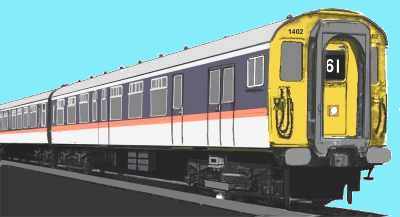
Class 412 4-BEP
An outer suburban two or four car set. These 2-car and 4-car units were identical to the Class 411 sets (illustrated above), I do not know why they received a separate class number.
Class 413 4-CAP
An outer suburban four car set introduced in 1982, they were actually pairs of two car Class 414 unit (illustrated below). These operated interchangeably with the Class 414 2-HAP and Class 418 (2-SAP).
Class 414 2-HAP
An outer suburban two car set, again built to both SR and BR body styles. They are visually identical to the Class 418 (2-SAP) & Class 413 (4-CAP)A kit is available from BH Enterprises
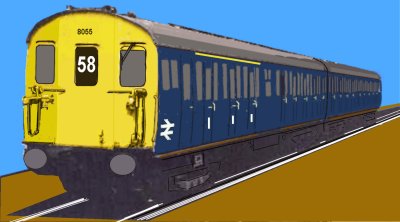
Class 415 4-EPB and 416 2-EPB
Inner suburban four car (4-EPB) and two car (2-EPB) non gangwayed sets introduced in 1951 using an SR body style (with the guards compartment behind one of the driving cabs), more were built in 1960 using a BR body style (with a guards compartment at the center of the rake). In 1990 the last Bulleid-designed set (415001) was given a Southern Railway green livery to mark the end of SR designed stock in service and was subsequently stored then scrapped. A kit is available for both types from BH Enterprises
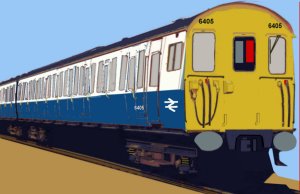
Class 418 2-SAP
An outer suburban two car set. They are visually identical to the Class 414 2-HAP (illustrated above) and Class 413 2-CAP.
Class 419 (MLV) motorised brake van
An unusual vehicle, first introduced in the 1950s and based on a BR Mk 1 full brake van fitted with a driving cab at each end behind one of which was a battery compartment allowing use on non electrified lines. They were introduced for use on boat trains as existing stock lacked the needed luggage space and the battery power allowed them to operate onto the dockside towing loaded parcels vans. As they fell from use in the 1990s (after the Channel Tunnel opened and ferry services were reduced) they found further employment as 'shunters' in depots. In the sketch below the battery compartment is at the far end of the vehicle.
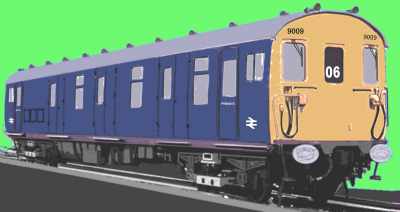
Given their date of introduction it is likely they were initially in all green livery with small yellow panels. I have found photographs showing these vehicles in plain blue as per the sketch but also in blue and grey, with the grey band extending right to the ends, and also in 'jaffa cake' London and South Eastern sector liveries but not in NSE livery (they may have received this livery, I simply did not find any examples).
Class 420 4-BIG
Main line units introduced in the 1960s, based on a simplified Class 411 CEP body design (illustrated above but see also Class 421 illustrated below) and retaining the traditional slam doors, one visible difference from the Class 411 was the jumper cables housed in recesses under the cab windows. The guards compartment moved from behind the cab at one end (the traditional SR placement) to one of the centre cars which also housed the pick-ups and traction equipment (the preferred BR position). Refurbished from 1983, these units became class 422
A kit is available from BH Enterprises
Class 421 3-COP, 4-CIG
The Class 421 4-CIG are four coach slam door units, visually identical to the Class 420 units. Originally delivered in plain blue with yellow ends and a metal double-arrow logo on the cab side the sketch below shows the later 'inter-city' two tone livery with painted on BR logo. The first class section is indicated by a 1 on the door and a yellow stripe at the cantrail.
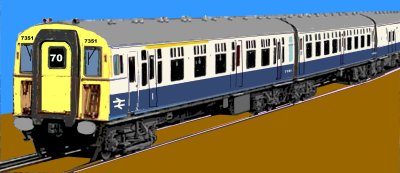
A kit is available from BH Enterprises
Class 422 4-BIG
The Class 422 4-BIG are four coach slam door units, they appeared in 1983 and are refurbished Class 420 sets ( visually identical to the Class 420 and 421 units, see above).
Class 423 4-VEP
4-VEP are four coach slam door high density units (lots of doors on the sides). They are visually identical to the Class 427 (4-VEG) and Class 480 (8-VAB) units. A kit is available from BH Enterprises
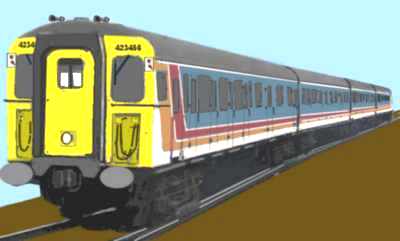
The sketch shows the final BR Network South East livery. The route indicator was not in use when the photo on which the sketch is based was taken.
Class 427 4-VEG
4-VEP are slam door units. They are visually identical to the Class 423 (4-VEP, illustrated above) and Class 480 (8-VAB) units.
Class 430 4-REP 431, and 432
Another in the series of BR Mk 1 coach derived EMU sets for use on third rail services, in this case they were built in 1967 for the Bournemouth services. They were also used with two four-car unpowered trailerClass 491 sets as the 4-REP had plenty of power for the resulting 12 coach set. At Bournmouth a Class 33 locomotive, fitted for push-pull working, took the unpowered sets on to Weynmouth. The 431 was a six-car set but with the catering facilities removed, the 432 was a pair of 430 sets run together as an 8-coach set. The 430 sets look, to my eye, exactly like a 438 set as illustrated below.
A kit is available from BH Enterprises
Class 438 (formerly 491) 4-TC
These were un-powewred four-car sets of Class 491 which originally ran as two sets coupled to a 4-REP high power EMU to produce a twelve car set. The 428s could also work with Class 73 or Class 74 locomotives or coupled to other high powered EMU sets. In later life, reclassified as Class 438 and with a modified gangway connector, they ran from London to Bournemouth, where the power car was replaced by a Class 33 locomotive fitted for push-pull work for the run out to Weymouth. The cars were all to the standard BR (SR) pattern, based on the standard Mk1 coach. They initially operated as Class 491 in all blue livery, as Class 438 they were in blue-gray livery and the top of the gangway conector was 'faired-in' to the roof profile.
A kit is available from BH Enterprises
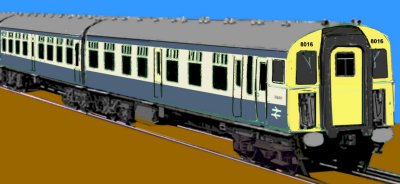
Class 442 5-WES
These were the first units to be based on the Mk 3 body shell, introduced in 1987 they used traction and control gear recovered from older units but proved reliable once the teething problems had been ironed out. Used for services south of London, initially in Network South East stripes, the example shown is in Southern Trains livery.
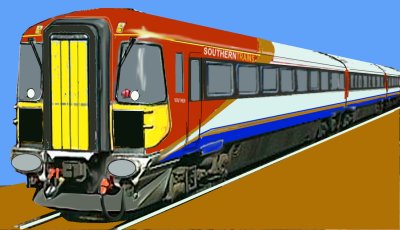
Class 444
The third rail, main line, variant of the Siemens Desiro EMU family, operated as five car sets. These units have a single door at each end of the coach in place of the more common high density pairs of doors spaced along the sides (see class 450 below). Unusually for modern stock 3 bicycles can be stored in 2 separate multi-purpose areas. The livery shown is Southwest Trains (a company with a great many veariations on its basic livery).
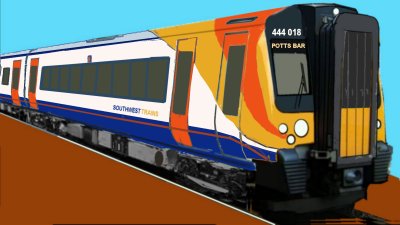
Class 445 4-PEP and 446 2-PEP
The PEP sets were prototypes to evaluate the first of the 'second generation' multiple units using cheap 'bus' type seats for commuter traffic. Two four car Class 445 sets (all-over blue livery) and a single two car Class 446 unit (plain aluminium livery) were built. During the trials they operated on Spouthern Region as a single ten car unit. The design formed the basis of several classes, notably Class 313, 314, 315 and the DC powered 507 and 508.
Class 450 Desiro
Another in the Siemens Desiro series (all looking very similar but fitted with different kit for different duties). The sketch shows the livery used by South West Trains, another variant on their basic colour scheme. These units are almost identical with the WCML 350 units.
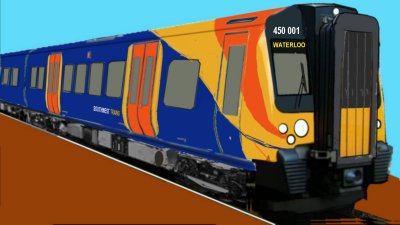
Class 455
These units were produced in quantity in the early 1980s for suburban services in the south of London. The first batch were actually three car sets were made up of redundant intermediate coaches from the Class 508s transferred to Liverpool. They have aluminium bodies with two pairs of pneumatic doors in each car, controlled by passenger operated push buttons. They appear identical in body design to the Class 313/314/315/317/507 and 508 sets but have a third rail pick up on the bogies, with a full coridoor connection (in place of the recessed escape doors) and external jumper cables on the cab front.
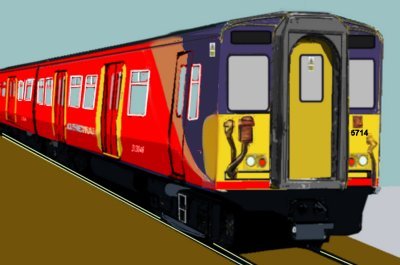
Class 456
Flat fronted modern units used in the South London area. The example in the photo was still in NSE livery in 2005.
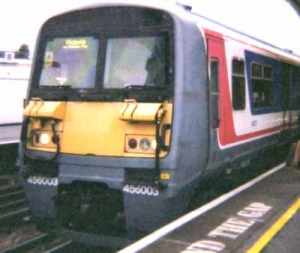
Photo courtesy Sara Dee (2005).
Class 458 4-JOP 'Juniper'
Introduced in 1999 these flat fronted steel-bodied and air conditioned units had a lot of teething problems. Now operated by South West Trains they can only work in multiple with other 458 units.The two sides of the cab are different, the far side (in the sketch) has a window into the drivers cab, presumably so he can see onto the platform.
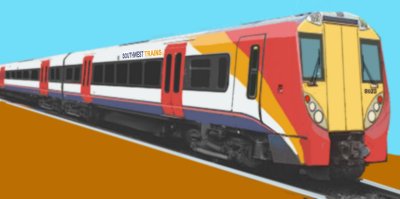
Class 460 8-GAT Juniper
These eight car units are used for the Gatwick Express service, replacing the Gatwick Express liveried Class 71 hauled services (the last of which ran in early 2005 I believe). The front end design of the 460 was apparently inspired by the Darth Vader character in the Star Wars film. They were introduced in about 2001, the sketch is based on a photo taken in 2005.
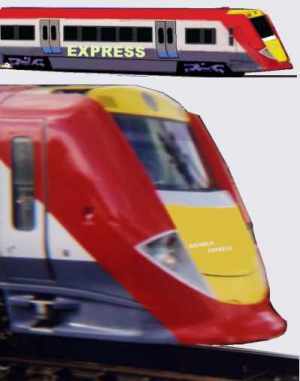
Photos courtesy Sara Dee 2005.
Class 465
Four car sets with welded aluminium bodies and branded as Networker when introduced in 1991 in Network South East livery. Identical to the Class 466 shown below, the only external difference seems to be the number of cars in the rake. The sketch shows the later Connex livery with blue upper panels.
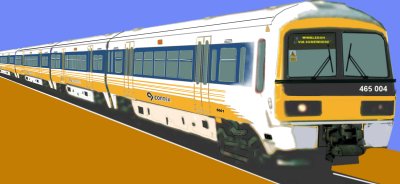
Class 466
Three car sets built to the same design as the Class 465 and as with that class branded as Networker when introduced in NSE livery during 1991. More recently they have been seen in Connex livery, as shown below, the sketch was made from a publicity photo showing a two car unit, I am not sure if they ran in this configuration however.
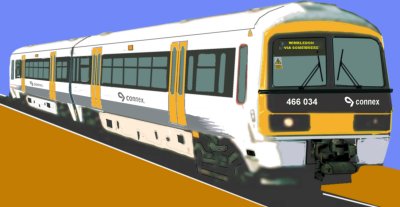
Class 480 8-VAB
8-VAB was a single 8-coach slam door unit made up of two Class 423 4-VEP units (illustrated above) for use on the Bournemouth line in 1968. It was visually similar to the Class 423 (4-VEP) and Class 427 (4-VEG) units.
Class 483
Two car sets introduced on the Isle of Wight in 1992. These are old 'tube' stock dating back to 1938 (the lines on the island cannot take full size mainland stock).
485 (4-VEC)
This is ex-London Transport 1920-30 built tube stock which was sent to the Isle of Wight. The loading gauge on the island was too small for mainland stock so the lines were electrified in 1966 and these 'tube' units put into service. The VEC designation does not refer to the brakes or other equipment, it is short for Vectis the Roman name for the Isle of Wight.
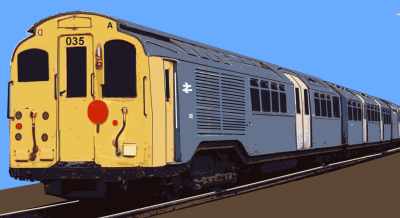
The Class 485 sets were replaced by two-car 483 sets in 1992.
486 (3-TIS)
Another set of early Tube stock purchased from London Transport for use on the Isle of Wight (see also Class 485). Very similar in appearance to the 485 shown above with slight differences in the vents and grilles.
487 (W&C)
SR built stock for the undergound Waterloo and City line introduced in the later 1930s. Originally operated in SR green livery they changed to BR blue but with grey ends, then Network South East followed by the privatised Waterloo and City Line colours. The line was converted to four-rail operation in 1993 when this stock was withdrawn, the former Waterloo and City line was then absorbed by the London Underground (becoming part of the Central Line) but I understand it retains its own livery. The sketch shows the BR all-blue livery used from the later 1960s.
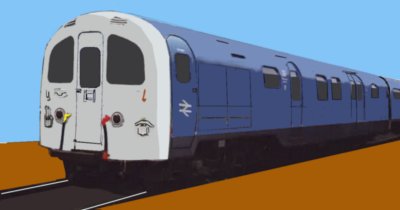
Class 488 and 489 GLV
Gatwick Express sets, introduced in the early 1980s (replacing 4-VEP sets) but actually comprised of rakes of Mk 2 coaches, modified internally and fitted with jumper cables to either side of the coridoor connection for use on the third rail network. The 488 sets formed up into pairs of four-car sets (class 488) with a driving trailer coach (class 489) at the end. The driving coach or GLV was a modified Class 414 2-HAP coach converted into a full luggage van by fitting deeper sides with three pairs of doors. Power was provided by a push-pull fitted Class 73 loco at one end with a modified 2-HAP driving trailer at the other end. Following privatisation National Express took on this service and arranged the purchase of the Class 460 eight car sets which entered service in 1999. The 488-489-Class73 sets were retained for a few years whilst teething problems on the new sets were ironed out. The power bogie on the GLV was operational, so when the sets were withdrawn (after an overhaul in 200) in 2005 and passed into departmental use. The sketch shows the Class 489 GLV attached to the rake of coaches in the later Gatwick Express livery (earlier version of this livery had the driving cab sides in yellow with the BR double-arrow logo in black below the drivers windows).
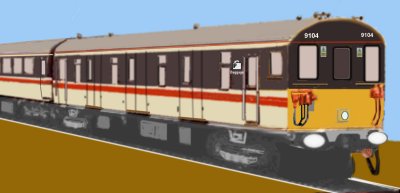
Class 491 4-TC and 492 3-TC (Became Class 438)
These were un-powewred four-car and three car sets which originally ran as two sets coupled to a 4-REP high power EMU set. They could also work with Class 73 or Class 74 locomotives or coupled to other high powered EMU sets. The cars were all to the standard BR (SR) pattern, based on the standard Mk1 coach. In later life, reclassified as Class 438, they ran from London to Bournemouth, where the power car was replaced by a Class 33 locomotive fitted for push-pull work for the run out to Weymouth. They initially operated as Class 491 in all blue livery, as Class 438 they were in blue-gray livery. A kit is available from BH Enterprises
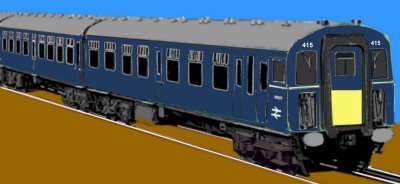
Class 930
This is actually a collection of third rail EMUs that have passed into departmental service. As these units are not equipped with modern safety systems they cannot travel on main lines unless they are part of a train of more modern vehicles. Drawn from various classes, Class930/0 are two-car units (used I believe for stores), Class 930/1 is a single motor driving trailer used as a depot tractor, and 930/3 are former Class 416 two-car sets used as part of sandite and de-icing services at Selhurst depot. These latter are (under Network Rail) painted all-over yellow and operate with a similarly liveries Class 31 locomotive.
Unusual BR EMU types
Class 501 650V dc four-rail
Three-car`North London Broad Street to Richmond` EMUs on the former LNWR lines. This line was electrified (using the four-rail system) in 1914 and the original stock ran for close on 40 years. The resulting Class 501 replacements built in 1957 and 58 had to be 57 feet long to fit the line and had bars on opening windows due to tight clearances on the line. I believe they were withdrawn in the later 1980s.
Fig___ Class 501 in BR suburban blue livery
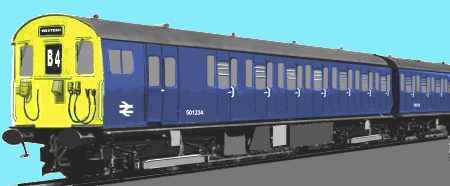
Class 502 630v dc third rail
The L & Y Railway electrified the Southport to Ormskirk line at 630v DC on a third rail system in 1904. The original clerestory roofed bow fronted stock (see illustration in the Pre-BR multiple unit section above) was replaced in 1939 by the LMS. The 502 differed from the earlier LMS electric units (based on standard LMS compartment coaches) in having an open (no compartment) design and pneumatic sliding doors (something not seen on main line stock until the second generation DMUs). They originally operated in LMS maroon livery but this changed to BR green in the early 1950s. By the early 1970s the units were in plain blue with yellow ends, wrapped round as far back as the cab doors. Withdrawals started in the 1960s but a few sets lasted until 1981.
Fig___ Class 502 in LMS livery

Class 503 630v dc third rail
The LMS Class 503, introduced in 1938 as 3-car sets, built for the newly electrified lines on the Wirral. The design was similar in appearance to the LMS 502 sets above but rather shorter in the body and with conventional shell type roof ventilators. Known as the Wirral units they ran out of Liverpool Central on the expanded LMS third rail 630v DC system in that area and lasted in service until the mid 1980s. They had two pairs of double sliding doors on each side of each coach, controlled by a push button, which was something rather new when they were built.
Fig___ Class 503 in BR era unlined green livery
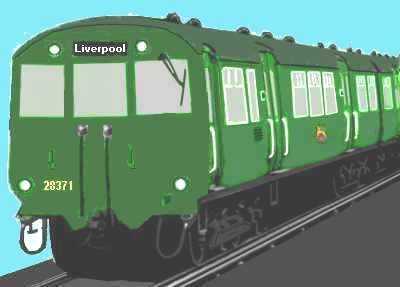
The sketch shows the as-delivered unit, later (in the 1970s I believe) a central door was added to the front (as an emergency escape route for use in tunnels, no corridor connection was fitted), this meant that two pairs of jumper cables had to be fitted, one pair to either side of the door. They got as far as plain blue livery with yellow ends wrapped round as far as the cab doors under BR but by the early 1980s the front was all over yellow and the sides were in red (lower) and cream (upper) Merseyrail colours. It was during the later period (possibly as late as the early 1980s) that they were fitted with the central 'escape doors'. The sketch fails to capture the classic styling of the front of these units, clean and uncluttered, leaning outwards toward the top as though hurrying forward with the very bottom curved outwards into an 'air dam'. The addition of the central doorway and second pair of jumper wires rather spoilt the effect.
Class 504 1200V dc 3rd rail, introduced 1958
Two car units for the`Manchester Victoria to Bury` service which had been electrified in 1916 by the Lancashire and Yorkshire Railway. The 504 class were replacements for the original L&Y stock and arrived in 1958. The line retained the third rail 1200v system until the Manchester Metrolink 750v dc overhead wire light rail system took over the route in 1991, when these units were scrapped.
Fig___ Class 504 in original BR lined green livery
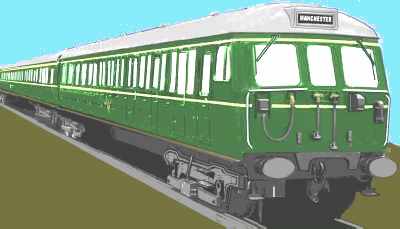
Note these units used buckeye couplers but to allow them to use screw link couplings if required (for example when being towed off their own line for repairs) they had a standard coupling hook and buffers as well. The buckeye would be used when working in multiple with similar units but could be swung down out of the way, in the sketch it can be seen below the buffer beam.
Class 505
Does not seem to have been allocated.
Class 506 1500v dc overhead supply
This was a small fleet of EMUs supplied in the early 1950s for the newly electrified trains pennine route from Manchester to Sheffield and a local branch to Glossop. I gather these units were 'clearly an LNER design' although they carried 'M' both as prefix and suffix to their number (the suffix indicated the region responsible for repairs and spares for the vehicle). The units featured pairs of sliding doors, controlled by the passengers using a push button, in the sketch below the double hinged doors of the guards compartment can just be discerned under the pantograph. The design of the pantograph itself as odd, incorporating elements of the early double-diamond type seen on the 1500v dc locomotives but also the later type used on the 25kV locos. The line used an overhead supply of 1500v DC. When the 'Woodhead Route' Manchester to Sheffield line closed in the early 1980s the Manchester-Glossop service continued in use running this small fleet of units (at which time it was the last remaining 1500v DC line on BR having just outlasted the Manchester to Altrincham line).
Fig___ Class 506 in BR blue-grey livery
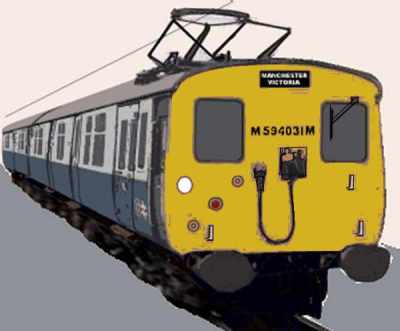
The trans pennine passenger services ended in the 1970s and the Glossop line was changed to 25kV AC operation in 1984 when these sets were scrapped.
Class 507
These three car units were (possibly are) third rail types used on the Liverpool 'Merseyrail' network painted in that operators livery. Introduced in 1978 they have aluminium bodies with two pairs of pneumatic doors in each car, controlled by passenger operated push buttons. They appear identical in body design to the Class 313/314/315/317 and 508 sets. Some Class 508 units were moved to Liverpool in the 1980s.
Fig___ Class 507 in early Merseyrail livery
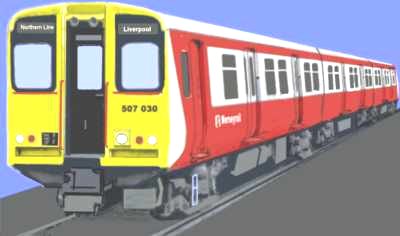
Class 508
Introduced on the South Western division of Southern Region in 1979 these four car sets featured sliding doors, controlled by the passengers using a push button. They appear to be the same design as Class 507 (see above). In the early 1980s they were all transferred to the Liverpool area operating as three car sets on the Merseyrail network and I believe may still be operating there. The missing coaches were subsequently formed into the first batch of 3-car Class 455s for use in the London area. A few were subsequently sent South to Kent in the post privatisation era, although I do not know when or if they have yet been withdrawn.
BEMU The Ballater Battery Unit - Introduced in 1958, withdrawn 1962 (see text) - Allocated to ScR.
This was an experimental unit made up of an original Derby Lightweight two car set (see DMU section for an illustration) fitted with about thirteen tons of batteries for use on the Ballater line in Scotland, where hydro electric power was being introduced. The set resembled the original Derby Lightweight vehicles but lacked the diesel engines slung underneath (replaced by a lathe battery compartment) and the small grille on the front of the cab. The unit entered service in 1958, had occasional periods of withdrawal for fitting different batteries etc and was withdrawn in 1962 but may have operated again subsequently (possibly as late as 1965). It operated in standard lined BR green DMU livery and carried a single 'lion on wheel' BR logo one each side for its entire service life.
Fig___ Ballater Battery Unit

After they were withdrawn from service the unit was stored for a time before being passed to the Railway Technical Centre at Derby. There the set was repainted in blue then received the blue orange and white RTC livery for trial of BRATO (British Rail Automatic Train Operation). This livery is shown in an illustration in Appendix Four- Locomotives - Introduction. In 1987 the set was sold into preservation and has been restored for use on a preserved line in Scotland in its original green livery.
^
Go to top of page
International Good Guys ~ Making the world a
better place since 1971 ~ Site maintained by

All material Copyright © Mike
Smith 2003 unless otherwise credited

























































































